2018 Sicily
August 3, 2018
A Sicilian Encounter

3rd – 27th August 2018
In August 2018 Annabel decided to celebrate her marriage to Justin with a weekend celebration in Sicily. This seemed like a good excuse to look round the island (Adrian had never travelled in Italy before). We hired a car at Catania Airport and over two weeks made our way round in a figure of 8, avoiding the popular resorts along the coast.
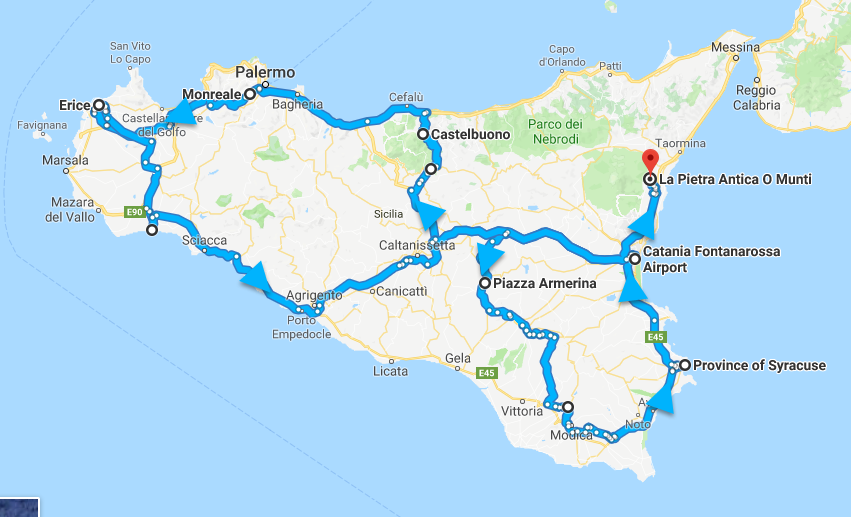
But before visiting Sicily we squeezed in a quick trip to the UK, and also a tantalising glimpse of Naples. We were away from Sydney 27 days, of which 18 were spent in Italy. We started by flying from Sydney to Bangkok.
Bangkok
3rd – 4th August
Our route to Europe follows a tried and tested pattern. It starts with day time economy class flights (with Singapore Airlines) to Thailand with an overnight stop in Bangkok. The next day we catch an overnight (Business class) flight with Turkish Airlines, and then fly on to London Gatwick.
Our overnight stop this time was in the Silom Serene Hotel off Silom Road, a favourite Bangkok hotel of ours.
With the opening of a new expressway the taxi trip into the city from Bangkok airport was easy, and only cost 500 Baht ($A20). At the airport there were two queues, one for normal taxis and the other for large taxis. We opted for a normal taxi which turned out to only have room in the boot for one of our suitcases. The other case travelled in the front passenger seat.
We had a full day free for sightseeing in Bangkok, so we took the MTR to the river side and then hopped on one of the Orange commuter ferries that ply up and down the river. We jumped off at Phra Summen, looked round the park, had a nice cold drink, and caught another ferry back. After that exercise we relaxed by the hotel pool then took showers to freshen up ready for the long flight ahead.
The Turkish Airlines schedule from Bangkok had been changed since our previous trip, presumably to avoid the increasing congestion at the old Istanbul Airport. The new schedule resulted in us arriving in Turkey at 3:30am. At least there were no queues for showers in the Business Class lounge so early! We caught the first plane out to Gatwick in the morning, and with the hour gained in flight we arrived in the UK before 10am. On the flight we were served breakfast – for the 3rd time that day!
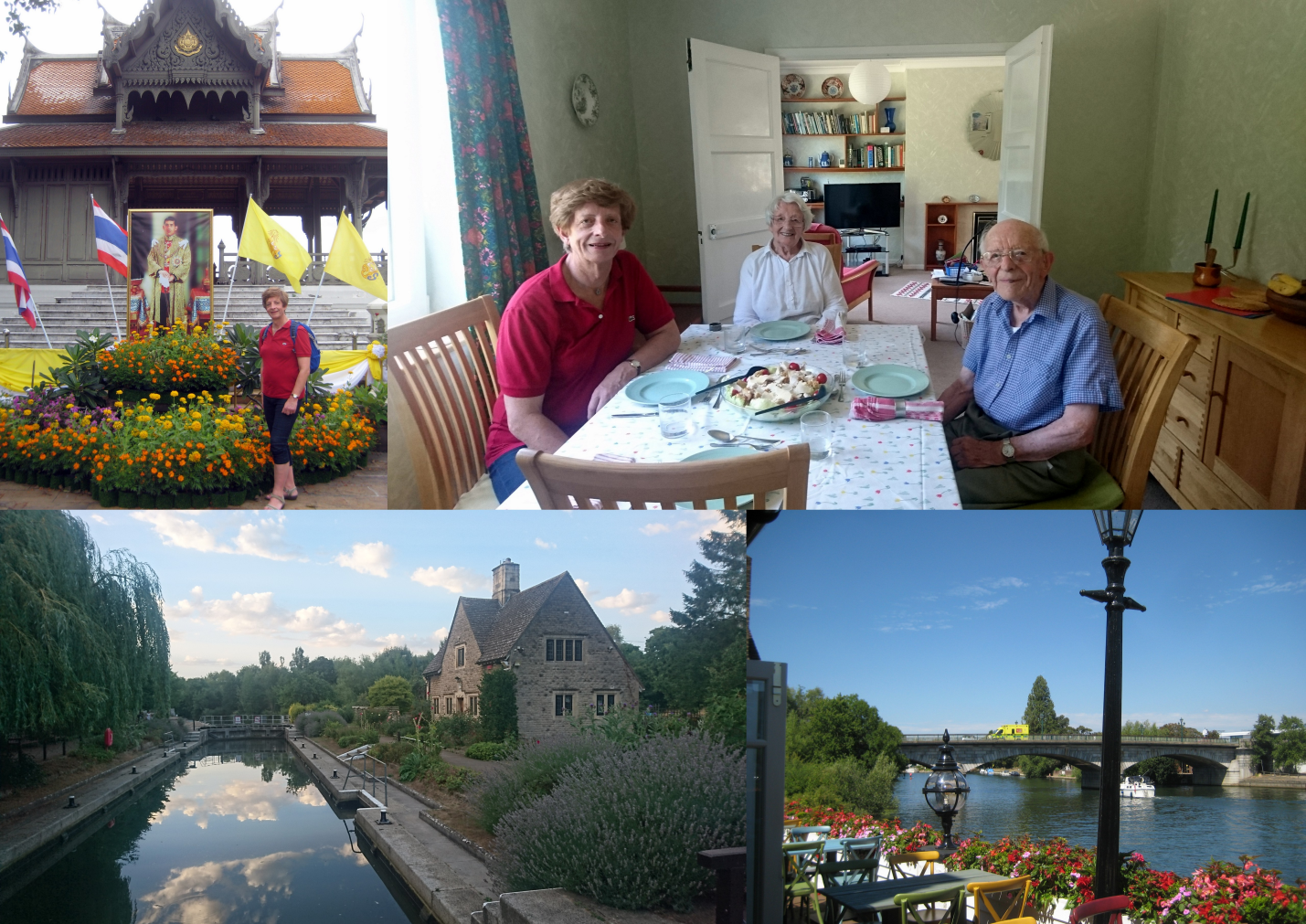
Abingdon
5th – 8th August
We chose to stay in Abingdon in the grandly named Abingdon Oxford Hotel. It was an old style motel currently being extensively refurbished and our room was in one of the last ‘old’ wings remaining. Because of the building works a free breakfast was included in the attractive rate. The other guests all seemed to be retired English tourists in search of a good bargain.
After clearing UK immigration we planned to pick up a car (see inset) and then zip round the M25 to Staines for a pub lunch with Dirk. We thought we had plenty of time, but we had forgotten about the traffic jams on the M25. When it became clear that we weren’t going to make it round to Staines in time for lunch we gave Dirk a call. It turned out that he too was stuck in an M25 traffic jam, just a few miles ahead of us. Together we crawled round London and both arrived at the Swann Inn in Staines at about the same time. This was the venue where Adrian held a 60th party but Megan had not been there before. We had a reserved table looking out onto the Thames and caught up with Dirk’s news. Not wishing to get stuck again on the M25 we cut cross-country to Winsor and used the M4 to get to Abingdon.
| The Hazards of Car Hire Picking up an unfamiliar hire car can be quite a challenge with a dose of jet lag, and a poorly indexed instruction manual. The Ford we were ‘upgraded’ to at Gatwick posed a couple of big challenges before we could even leave the parking lot. There wasn’t room in the crowded car park to put our suitcases in the boot, so Adrian jumped in to move the car forward slightly; but where was the handbrake? Letting the clutch out gingerly just stalled the engine. After a lot of searching in the manual it turned out there was an electric hand brake and the switch to release it was on the passenger side! Our troubles with the car weren’t over because we couldn’t turn out of the parking space in one go. When it came to reverse Adrian couldn’t figure out how to engage the gear – we just kept inching towards an unmovable brick wall in front of us. Out came the manual again and it turned out there was a locking ring one had to lift to engage reverse. It appears we have been driving an automatic car for too long! |
England was in the middle of a summer heat wave, and of course when booking a hotel in the UK one doesn’t naturally look for air conditioning. Luckily our room did have an oscillating fan, and after the long trip not much would have kept us awake. After 11 hours sleep we were feeling a lot more refreshed the next day.
After a lunch with Adrian’s parents (which included a delicious French cherry pudding) we visited Oxford. We couldn’t help noticing that the voices on the streets were all foreign tourists. We admired the new Westgate shopping centre architecture, but didn’t buy anything there.
The pub where we had arranged to meet up with David (an ex-work colleague of Megan) and Sherelyn was on the Thames flood plain with no road access. So make it easier to walk there, we parked the car in the narrow streets of old Iffley village. As we were crossing the lock Sherelyn came up behind us on her bike. It was a lovely summer’s evening and we sat outside in the beer garden chatting. The evening finished with a look at the recently restored exterior of Iffley Church (it had a somewhat Byzantine look) and coffee chez David.
The next morning it was time to make our way back to Gatwick, via the large Marks & Spencer store at London Colney (St Albans). After making a few non-essential purchases and enjoying a light lunch we carried on clock-wise round London, passing over the Dart Crossing (a first for both of us). Megan offloaded the suitcases at the Premier Inn North terminal and Adrian returned the hire car to the South Terminal.
Our last social engagement in the UK was to have dinner with Phil and Elizabeth. We caught a train to Reigate where we met up at an Indian restaurant. Phil dropped us back at our hotel afterwards so we could repack our bags ready for the morning.
Leaving the UK
At Gatwick South Terminal we tried to check our luggage through to Naples, hoping that by doing so we could make ourselves eligible for a complimentary Turkish Airlines overnight hotel in Istanbul. But the clerk wasn’t able to merge the tickets as our Naples flight was still over a day away. That meant we didn’t have any where booked to stay overnight in Istanbul (though we had taken the precaution of buying Turkish visas in advance). So the first thing Adrian did when we got to the Premium Lounge Wi-Fi was to book a room on LastMinute.com. It was good that we hadn’t had to pay for access to the lounge, as it was packed and hard to find anywhere to sit.
The early flight from Gatwick which we took was scheduled to arrive in Istanbul after the last flight to Naples for the day had left. In order to make the connection to Italy through Turkey we needed to stay overnight. Our choice of hotel was dictated by convenience – we stayed in the land-side airport hotel. Because the Turkish Lira had just conveniently crashed in value the price for a premium hotel was quite reasonable (though Turkish Delight was still outrageously expensive in the airport). We had dinner in the hotel restaurant whilst we watched all the ground air-side activity at the terminal gates through the large windows.
Our flight to Naples left the next morning at 8:30, so we skipped breakfast. But we got our money’s worth by taking the hotel shuttle the short distance round to the departure floor.
Naples
9th – 11th August
Our boutique hotel in Naples was centrally located close to the port on Via Medina. Although the Palazzo Turchini was on a busy street our room on the 4th floor was surprisingly quiet. Breakfast was served in a bright dining room on the top floor. The hotel recommended a trattoria across the road for dinner and we took their advice. It was fun sitting out on the pavement in the warm evening people watching and enjoying typically Italian food (and wine).
Getting to Italy
It was a long wait for our priority baggage to turn up at Naples and by the time we set foot in Italy it was lunch time. To avoid having to find something to eat on our way to the hotel, we opted to have our first Italian eating experience at the airport. The restaurant was very popular, which was a good sign, but our ordering technique needed refinement; Megan ended up with a plate of deep fried vegetables!
The Alibus shuttle to the port area was well signposted, but involved quite a walk from the terminal to the bus stop. We skipped the first bus which was there when we arrived as it was full, and we waited for an empty bus so we could sit down. The walk from the port to our hotel had been planned on Google Street View to avoid uneven surfaces. But Google didn’t preview how hot it would be wheeling two suitcases up the ramp beside the Castel Nuovo.
There wasn’t much time to freshen up or unpack before we had to head out again, as we had to catch the last tour of the San Carlo opera theatre. Although the tour was in Italian we bought tickets, and we understood very little of the commentary. The pedestrian streets nearby were very attractive – particularly the covered over Galleria Umberto I built in 1737.
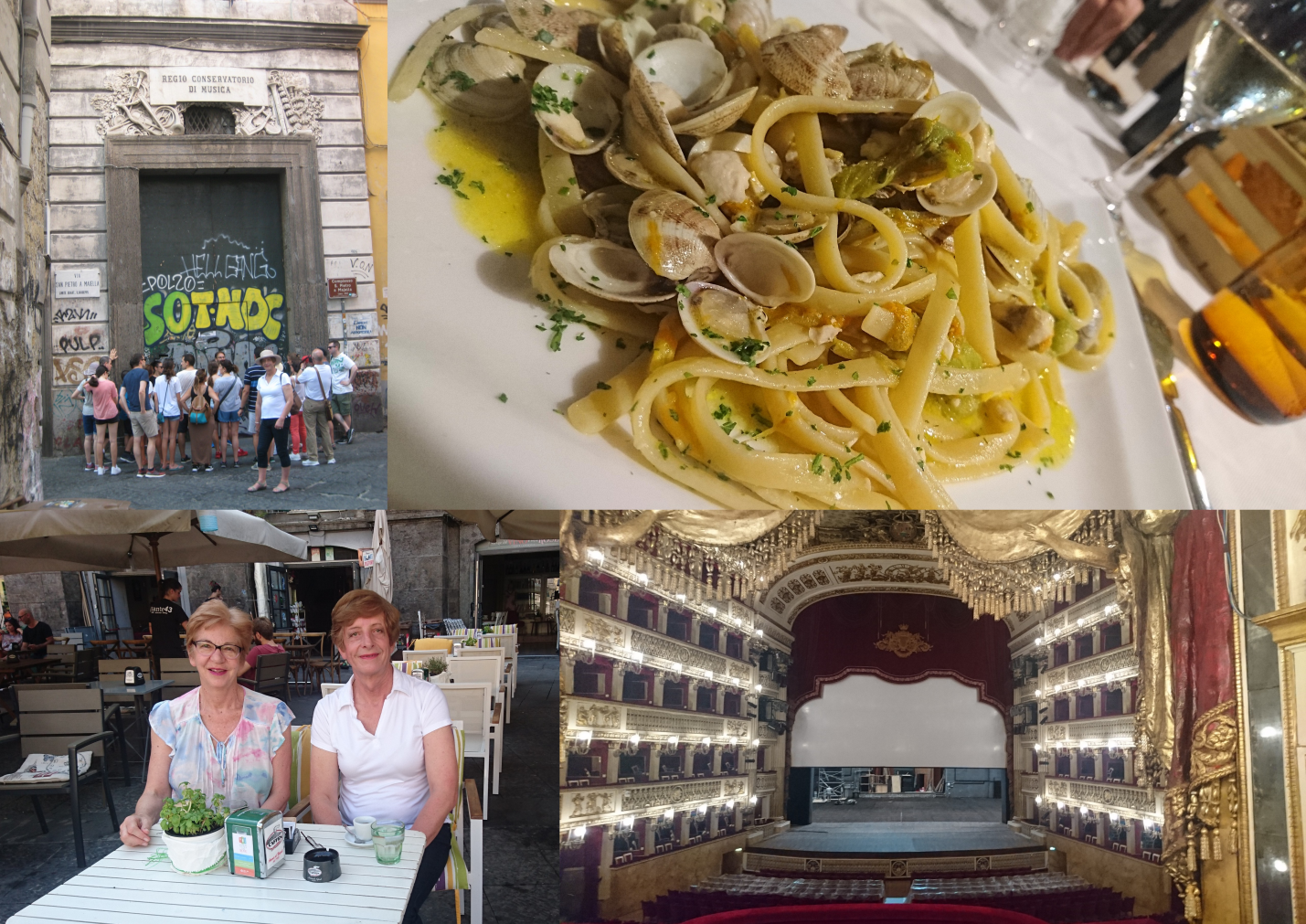
Sightseeing Naples
We had a full day sightseeing in Naples. We could have spent longer and rushed less. The old city is to the north of the port, easily reached from our hotel on the metro. Getting to the correct metro platform was however not so easy, we used up our tickets incorrectly getting access to the south-bound platforms and had to gate hop through the correct entry.
| Italian Style We were impressed by the understated style of Italian dressing. There was quality from the bottom up, starting with the shoes which were stylish and well made. Only tourists seemed to wear trainers. We were less impressed by the young Italians on holiday with their tops bearing slogans in English. It seemed to be more important to wear something with English words, than that the words made any sense! |
At Piazza Dante we were scheduled to pick up the Napoli That’s Amore free walking tour. As we arrived early Adrian was able to enjoy a real Italian coffee whilst we waited. There were about 20 visitors on the tour, including quite a few Italians who struggled with the English commentary. It was a hot day, but our guide cleverly managed to stop where we could stand in the shade. As we wandered through the Centro Storico he introduced us to the oldest (and best) Pizza vendors, the history of the city built on Greek and Roman foundations, and some of the interesting architecture. We willingly gave a generous tip to the guide at the end, as the tour was hard to fault at any price.
When it came to our turn to find a pizza restaurant for lunch, we ignored the tour guide’s advice and opted instead for a place that had air conditioning! It might not have been the best pizza in Naples but at least we ate it in comfort.
A tour of Napoli Underground was another opportunity to avoid the heat of the day, although it involved quite a time queuing outside as they formed different language groups. Once underground, the tour explored a network of tunnels built by the Greeks for water distribution and subsequently used for a variety of functions. In one section the group was issued with torches and had to squeeze through a long passage so narrow one had to walk sideways. After exiting out of the aquafers we were taken to a house on a side lane which had been built on top of the ruins of the Roman theatre. When one descended to the cellars the old walls were clearly visible.
Although we were exhausted there was one more stop left on our itinerary. We had pre-booked tickets for the Museo Cappella Sansevero (unnecessarily as it turned out as it was very quiet late in the afternoon). The café nearby where we grabbed a drink was one of the few times we were ripped off in our entire time in Italy. The marble statues in the chapel draped in veils and netting were superb examples of 18C craftsmanship.
| The New Naples When we suggested visiting Naples the almost universal advice could be summarised as “Why Bother”? Certainly, Naples has picked up some bad press in the past with violence, crime and garbage strikes. But the city we visited didn’t have any hint of being dangerous or unpleasant. The streets were clean, the people friendly, and there was so much of interest to see. We were expecting our visit to the central railway station to be risky, but it just appeared to be like any other main city station. |
Off to Sicily
The next morning we set off for Sicily, by train. Getting to the Central Railway Station on the Metro had its challenges; the ticket machine couldn’t be persuaded to issue tickets so Adrian had to return to street level and buy them in a kiosk. But at least we knew which platform entry to use this time.
The main station has had a reputation for crime so we were on high alert, padlocking the suitcases together and keeping our valuables well hidden. Adrian wandered off and bought some rolls and drink for lunch then we went in search of our train. Whilst we waited for the train to arrive, Megan spotted that it was already waiting – on the platform behind us! It was holiday time and the train was packed with Italians but no one was sitting in our reserved seats! In fact it appeared that many people didn’t have tickets at all and were just surfing up and down the train keeping out of the way of the ticket inspector.
The route south alternated between tunnelling under mountain spurs, and hugging the coast. At one point we were surprised to look out the windows as see we were passing through ruins of the Greek city Paestum. The end of the line was Villa San Giovani station where there were long delays as the train was made ready to be shunted onto a ferry. The train was split into two, pushed onto the ferry, and then the passengers were unloaded so they could watch the short crossing from the decks.
In just under 30 minutes we were docking in Messina and had arrived in Sicily.
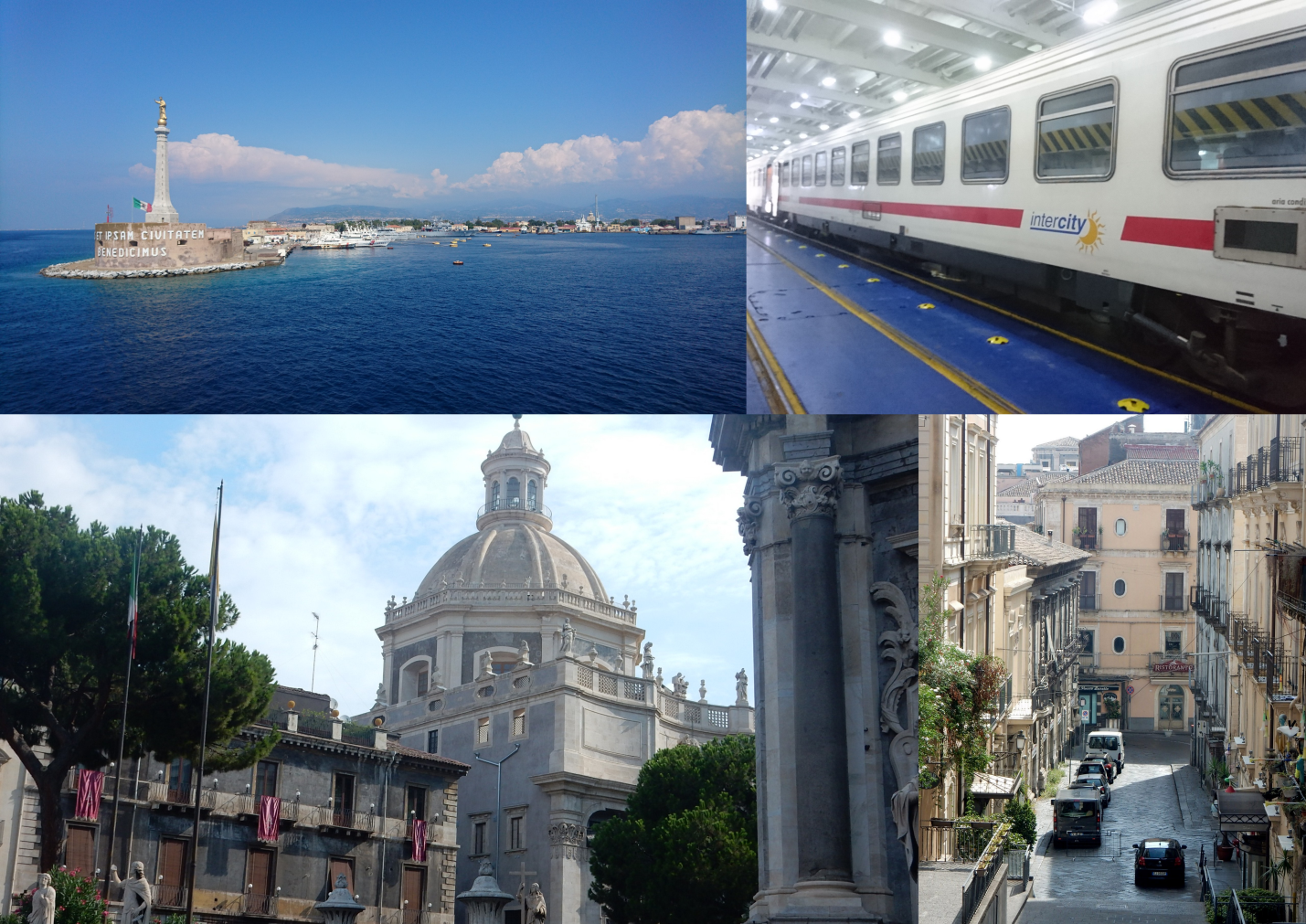
Catania
11th – 12th August
In Catania we stayed near the main railway station in the Palazzo Turchini hotel. It was on a side street, and the rooms mostly looked out onto a central first floor courtyard, so there was little street noise. Our room had the convenience of an opening door onto main courtyard (and breakfast room). The hotel didn’t have a restaurant but there was a nice traditional trattoria nearby, I Moschettieri, in the same block as the hotel, was well fraternised by locals and helped us navigate round our first Sicilian menu.
Sightseeing Catania
| Sicily with Suitcases Sicily with its hill top towns and narrow streets is not friendly to those with restricted mobility. On arrival in Catania we found that we were in that category (for the first of many times) wheeling our two suitcases along. Catania central station didn’t have any lifts so we had to struggle down to the subway, and back up again to street level. |
Although we selected a hotel that was close to the station and airport shuttle bus, it turned out to also be within easy walking distance of the city centre. Before we checked out on Sudnay morning we set out to have a look at the city. Walking to the Piazza Duomo the streets had the feel of Cuba, crumbling elegance. Unfortunately, because it was the weekend, the fish market was closed; but we wandered round the tree lined pedestrian-friendly streets.
Catania is the birth place of Bellini so we diverted on the way back to pass the Teatro Massimo Bellini. It has obviously seen better times and won’t be making its way into the list of the World’s Greatest Opera Houses.
We returned to the hotel, checked out, and then with our suitcases in tow set off in a search for the AliBus airport shuttle. Luckily we weren’t in any particular hurry to get to the airport because after buying tickets at the kiosk outside the station Adrian went off looking for a bus stop. But the directions the locals gave were delivered rapidly in Italian (or perhaps Sicilian?) and seemed to be contradictory. Eventually a helpful man pointed out the bus stop sign, half way up a lamp post pointing in the wrong direction. We waited in the appointed spot and sure enough, eventually, a shuttle bus appeared.
At Catania Airport we joined a long queue of holiday makers waiting in the hire car offices. Once one got to the head of the queue the service was surprisingly efficient. Our car was sitting outside in the sun and the dash thermometer registered 45 degrees. We dumped the cases inside to melt and set off to the nearby Wood café to have lunch and wait for Annabel and Justin to arrive from New York.
The lunch rendezvous very nearly didn’t happen. Justin picked up his car from a depot in another part of the airport, and then couldn’t work out how to drive to the café. Eventually Annabel appeared, hot and flustered, replete with hiking boots, on the other side of a wire fence. The Wood café had a very limited choice on a Sunday but we took what was food available and got ready to set off on our respective adventures in Sicily.
Our adventure took us first to Piazza Armerina in the centre of the island, a 90 minute journey which was made easy by taking the main East/West freeway to Enna.
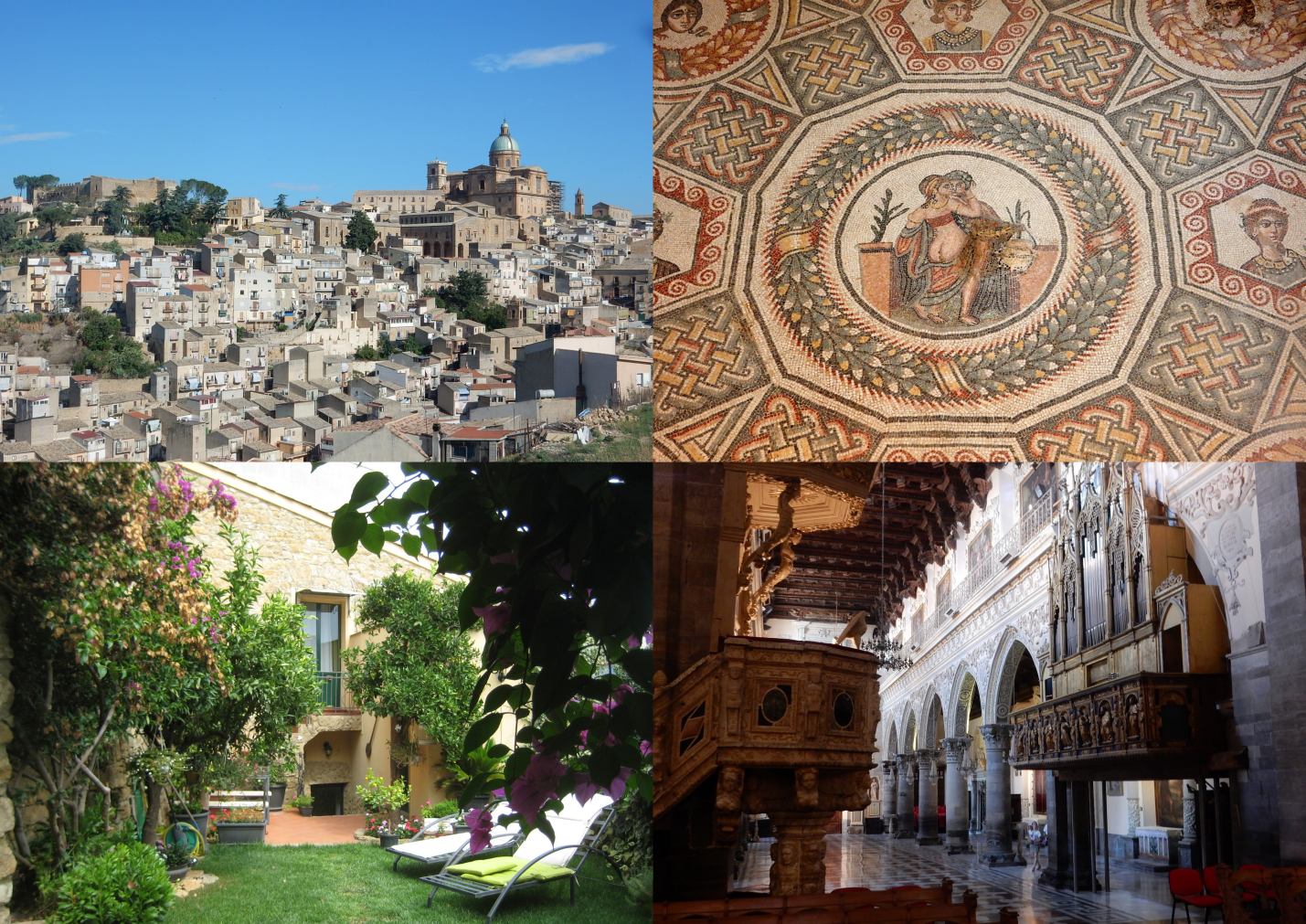
Piazza Armerina
12th – 15th August
Piazza Armerina is a less visited hill top town in the middle of Sicily. Our reason for including it in our itinerary was that it hosts a three day re-enactment of the Normal conquest – the Palio Normani. Our base for the three days was a highly recommended bed and breakfast on the outskirts of the old town. The Giardino della Zagare was on a narrow lane built for mules and not cars. It was decorated and run by a couple with impeccable taste. Our attic suite was bright and comfortable, but the headroom was a bit low upstairs. There was a kitchen (with no utensils), a separate lounge area, and a small bathroom.
Getting there
| Navigating with Google (1) Google Maps had trouble with the Sicily roads – all those one way streets, lanes too narrow for cars, and steps , clearly challenged the algorithms. Google was optimistic about the prospects of driving to our B&B in Piazza Armarina. But on closer inspection part of the route it used was clearly shown on Street View to be up a flight of steps. When Google was gently persuaded not to take that short cut it came up with an alternative route – which went straight through a church. You could almost hear Google sulking when instead we opted to just park in the nearby public parking. |
Arriving at an accommodation with no road access was always going to be tricky. When we emailed the owner and asked how the preparations for the Palio would affect things we received a “don’t worry” response – so we didn’t.
On arrival we pulled into a street below the accommodation and rang the B&B – but there was no response! Plan B was to park in the public parking area and walk from there. But unfortunately we were now in a one-way street that went to the old town centre – so there was no turning back. Following Google’s instructions we drove to the central Piazza and then turned onto the main street out of town. But the road was closed for the Palio parade, no diversions, just closed. Google was now no help at all, so we resorted to driving round in concentric circles looking for an alternative exit from the town. It was a sudden baptism into Sicilian hill-town driving – lanes barely big enough for a car, steep rough cobbles, and of course, no signs. Eventually we found a way to exit the town on the far side, skirt round road closures, and with some relief find space in the public parking area.
But our adventure wasn’t over with the car parked. We wheeled the two cases past the church Google would have had us drive through, and down a lane that got steadily narrower. Right at the end was our B&B – behind a locked gate. We tried phoning again, and although we could hear the mobile ringing inside there was still no answer. So Megan resorted to shouting; and then shouting a bit louder. Eventually one of the other guests came down and let us in, but no owner was around.
We set ourselves up to wait in the comfortable communal area, and helped ourselves to the cake and biscuits on offer. A thunderstorm started to brew over the hills and eventually Adrian decided to take executive action. After researching all the rooms there was one that seemed to match the description we had from Booking.com , and a room key was hanging on the wall; so we moved in. It was quite a while later that the owner turned up rather sheepishly, and explained that he thought his partner was going to stay at home.
Of course there were no lifts, so somewhere between lugging
the suitcases from the car park to the attic bedroom Adrian’s back got
sprained, and it remained sore as a
reminder for the rest of the holiday.
The Palio Normanni
The Norman Palio is held each year in the historic centre of Piazza Armarina. With ladies in costume, knights on horseback, and troops in uniform it is a unique spectacle. Four historic quarters of the town compete against each other, dressed in distinctive colours.
On the first afternoon the delivery of arms to the teams took place close to our B&B. Unfortunately the heavens opened when the celebration was due to start. When the rain stopped it was already time for us to have dinner, so we headed to the Trattoria Da Gianna. This restaurant was close to all the action and we watched the teams marching away to the Cathedral to be blessed before sitting down to a meal.
The weather was much more favourable on the second afternoon, when the militias make a triumphal entry into the Cathedral Square. We sat on the steps of the local church watching “our team” assemble. The marching band was smartly dressed in red, and the young ladies in green. Instead of the traditional medieval tune, our band was playing an excerpt from “the Game of Thrones”. When they set off, we repositioned ourselves above the main piazza and watched the procession, including jousting knights and their horses, climb the hill to the Duomo. Each team then processed the Cathedral Square with great ceremony.
The jousting contest or Quintana on the third evening was held in a stadium across the valley from our B&B. When we got there the stadium was already at capacity. We did some sightseeing round the town and found that a live stream of the jousting could be viewed on a large screen in the main square. We ate early at Trattoria Al Goloso before the crowds arrived (we got the last table). The Quintana was still going when we went to bed! Sadly our “home team” didn’t win – the prize went to Yellow (Monte).
Villa Romana del Casale
The roman villa, Villa Romana del Casale, is only a short distance away from Piazza Armerina so we were able to get there before the coach trips arrived. There was plenty of parking, but it had an hourly fee (paid on departure) and was some distance from the site.
The Roman villa was easy to visualise, as the protective structures that have been erected mimic the shape and scale of the original buildings. The villa was much larger than we were expecting, and there were far more mosaics. The floors were in excellent condition (thanks to being buried for centuries under a landslide). The only gripe was that a few of the mosaics were upside down when viewed from the walkways.
By the time we left the arcade of tourist stalls in the car park had opened and we were able to buy postcards (although we were supplied the stamps for Austria not Australia).
Enna
The hill top town of Enna lies about 40 minutes’ drive north of Piazza Armerina and rises above the arid central valley leading down to the coast at Catania. Access to the old town is through a set of hairpin bends which lead up to the castle. Once at the top, there was plenty of free parking. After all those bends we needed a coffee and eventually found a café on the Plaza Duomo. The 14th century cathedral was plastered with artworks, even high above the nave. The coffered wooden ceiling was particularly attractive.
The walls of the Castello di Lombardia which date from the 12th century are well preserved. We were surprised to find there was a free guide (human) provided by the local council, but the many notice boards round the site were very informative. We climbed to the top of the Torre Pisana for its excellent views over the valley, including across to the hill top town of Calascibetta.
Back in town the search for lunch revealed a number of overpriced restaurants in Piazza Crispi cashing in on the stunning view. Instead we headed down a side street to the more modest Ristorante Centrale which served some good local specialities.
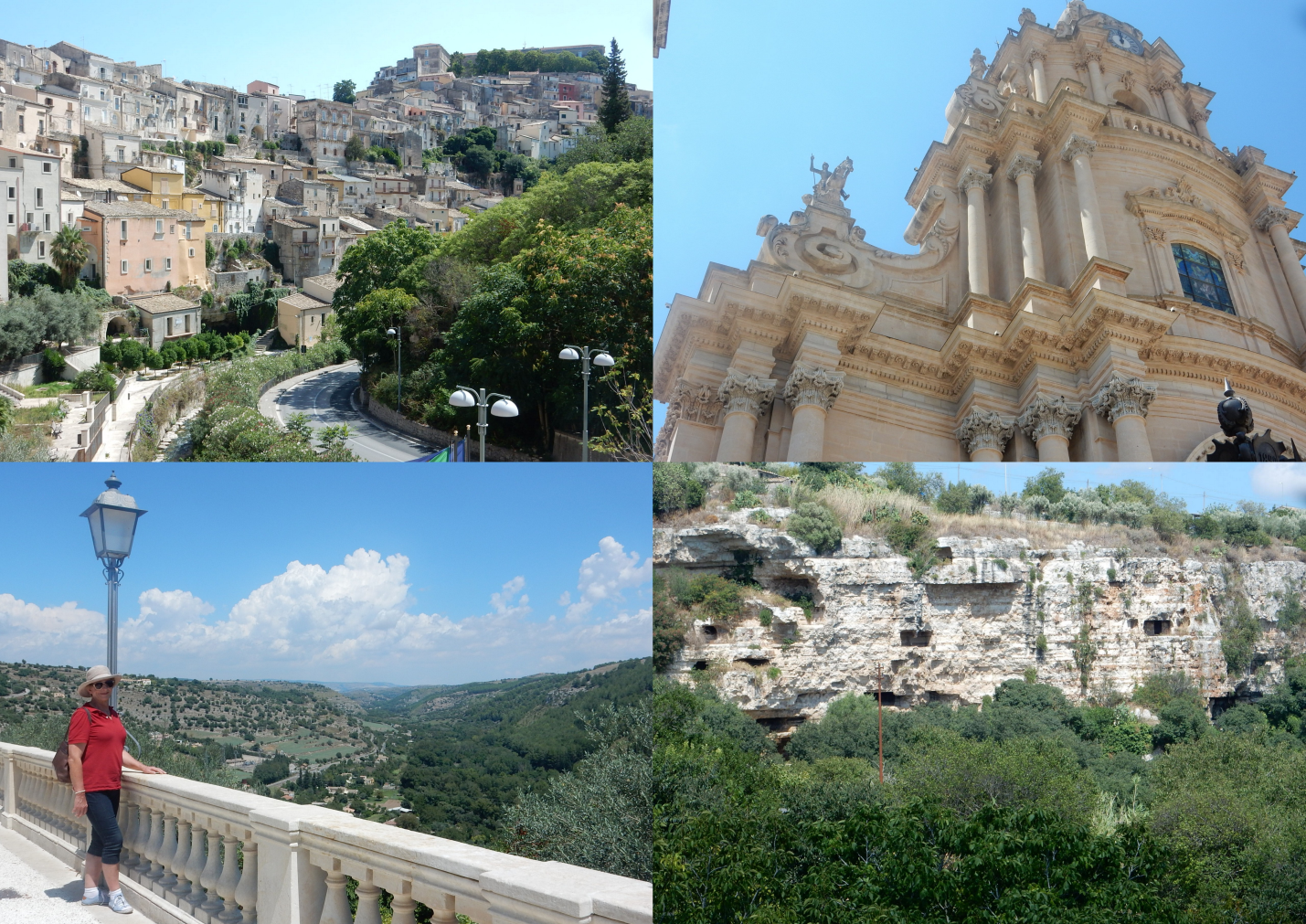
Ragusa
We left Piazza Armerina heading for Syracuse by an indirect route that took us past Ragusa and Modica. In 1693 Ragusa was devastated by a huge earthquake, which killed some 5,000 inhabitants. Following this catastrophe the old town was largely rebuilt in a Baroque style, and meanwhile a new town was created on an adjacent hill. Ragusa had an easy-to-reach public car park between the old and new towns. It was nearing lunch time when most of the churches would be closed, so we looked into the Chiesa Anime Sante del Purgatorio which sits by the Valle dei Ponti which separates the old and new towns.
There is no plan to the streets in Ragusa Ibla (the old town), and we soon got lost without any landmarks to be seen in the narrow lanes. When eventually we saw the dome of the cathedral we knew we were close to getting close to our morning cup of coffee. The main square is very touristy, but we found a café where we could sit in the shade to drink. It was a public holiday so many of the shops were closed.
At the end of the spur on which the old town is built there is a nice shady park – the Giardino Ibleo. Inside the park there is an interesting church, and promenades with good vistas into the valley below. Walking back to the car we kept off the main street and it was much quieter.
The next Baroque hill-top town is Modica, but we bypassed it as there appeared to be no easy place to park for a quick visit. The bypass crossed over a deep valley below the town but we were unable to find a viewpoint to take a picture of the slender bridge.
The final place we planned was to visit was the Cava d’Inspica. Located in a long valley cut into the plateau, the caves contain prehistoric burial sites, Christian catacombs, monastic hermitages and medieval settlements. Unfortunately the ticket office closed at midday on public holidays and so we were locked out. As Plan B, we drove back along the the valley and then took some farm lanes to get closer to the edge. From there we were able to see the caves at a distance that we were unable to visit close-up.
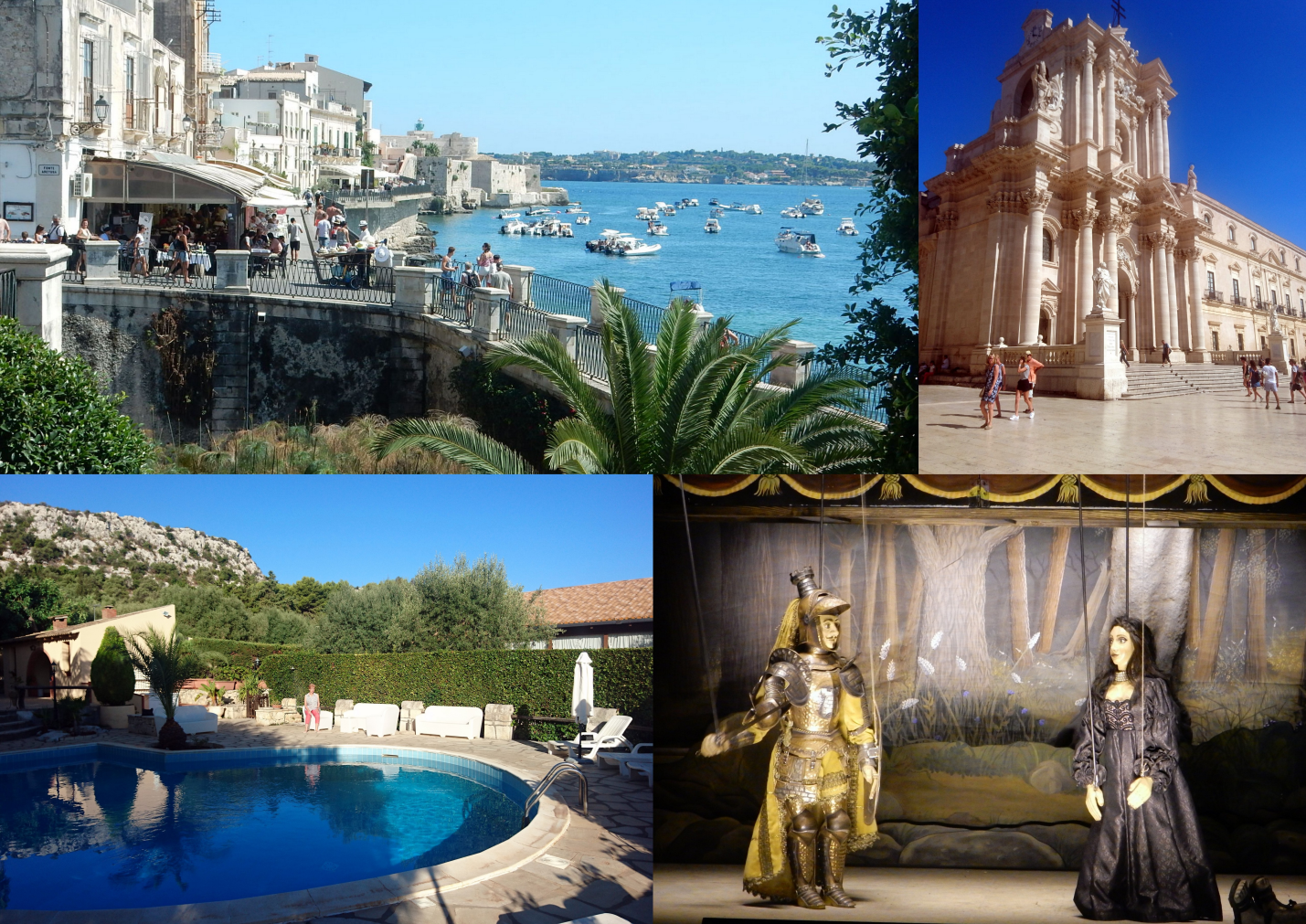
Siracuse
15th – 17th August
We chose to stay in an Agritourismo in order to visit Syracuse. We were perhaps expecting a cottage on a relaxed citrus farm, but the Agritourismo La Perciata felt more like a resort, with a focus on hosting wedding celebrations. Our small but comfortable room was in a freestanding block close to the pool. We arrived late on the first night. It was a public holiday and we didn’t want to go out again searching for a restaurant that was open, so we ordered dinner at the Agritourismo. The hotel had set up tables in a courtyard near the pool. We enjoyed a rather expensive but well cooked buffet meal with ‘entertainment**’. Breakfast had a good range of local produce, but the breakfast room was too small. When all the guests sat down you couldn’t easily get to the buffet.
**A man singing Italian karaoke with a daughter who (supervised by mum) did a few traditional dances with him.
Syracuse & Ortega
A whole day was ours to go sightseeing in Syracuse, and the island of Ortegia. Skipping the heavily visited Greek theatre (once you’ve seen 50 you’ve seen them all!) we went instead to the Catacomba di San Giovanni. The church was in a very non-descript area between industrial wasteland and residential blocks. We were early so there was still space in the small car park outside. A tour of the catacombs (in Italian and English) was just about to depart so we purchased our entrance tickets and also a scratchy 1 hr parking ticket. Adrian raced back to the car carefully scratching the date (in Italian) and placing it inside the car. Whilst doing this two Italians came up and asked how to get a ticket and got an answer in Italian!
The Catacombs are roomy and well ventilated, having been built within the old Greek city aquifers. There are lots of rock tombs, but all were empty thanks to the caves being used as an air-raid shelter in the war. Our tour was very good with many interesting facts. Included in the ticket price was a visit to the Basilica of San Giovanni Evangelista next door (a ruined, roofless, church) and the Crypt of San Marciano (the alleged burial place of St Peter).
| Parking in Sicily Driving a car in Sicily is easy compared to finding somewhere to stop driving. To make parking easier there are colour-coded markings on the road, white for free parking, and blue for paid spots. But of course there were very few vacant free parking places anywhere. The Italians approach this problem creatively by utilising any flat space to park – including footpaths or if that fails, the middle of the road. Parking in Syracuse highlighted the problem. When we parked on the mainland we had to take a paid (blue) parking spot but there were no signs explaining how one should pay. Moving to the island of Ortigia we assumed there would be no parking issues as Goggle showed a large expanse of “Parcheggio” by the waterfront. But it turned out to be an area of blue spaces with no parking meters. In the end we joined a long queue to enter an undercover carpark that clearly offered the option of staying for a long time. |
Driving into the island of Ortega was easy, but finding somewhere to park was a different matter (see inset). Heading off on foot down the narrow streets we stumbled across the Puppet Theatre where we bought tickets to the early evening performance.
After a stop for cold drinks we wandered further into the old town, leaving cars behind us, and diving down narrow alleyways. Our destination was the Jewish Baths (Ebraico – Mikveh ) on Via G.B. Alagona Bagno. The baths lie beneath a boutique hotel and were discovered by accident during renovations. We had just missed an hourly tour – but as no one was on previous tour the guide offered us a private tour so we didn’t have to wait. Stone steps lead down 18 metres beneath the hotel courtyard to reveal a rock chamber with a number of small baths cut into the floor. The water is very clean, and surprisingly we were told it came from the mainland. They have to pump the water out to stop the baths flooding. Unfortunately no photos were allowed at this unique site (a hotel picture is included in our album).
The search for light lunch options took us to a Vegan café! “Just Veggie” had a nice menu but the service was a bit lethargic – perhaps the staff were running low on protein! Over on the west side of the island we sought out a patch of green shown on Google Maps looking for somewhere shady to have a post-pranzo rest. It turned out to be the Fountain of Arethusa – an small area of tidal wetland well below street level! In fact there was a lower level walkway all along the shoreline, but we couldn’t see any easy way to get down to it. Eventually, after walking past the marina we found some highly polished marble steps and the much sought after park bench in the shade.
Navigating on foot through the maze of narrow streets on Ortega Island was difficult, and even Google maps had difficulty at times working out exactly where we were. But we found our way back to the Plazza Duomo by a circuitous route (which incidentally meant we saw the 19th century Fountain of Diana). The Duomo was dazzlingly white under a blue sky. There was a nominal fee to enter the church where the main attraction was to see the pillars of the original Greek temple that had been incorporated into the walls of the nave.
After rediscovering an ice cream shop we had passed on our earlier wanderings we looked at the Museo dei pupi siciliani in an old palace with a collection of marionettes, props and tools. Then we were ready to see an actual puppet performance. In a small theatrette we settled in to watch a play in Italian with a plot so complex it could easily have been an opera. The forte of the Sicilian puppeteers seems to be sword fights. Firstly the combatants would flick their visors down, then they would engage in a simulated fight, all to the backing of a rhythmical sound track. Finally one puppet would fall to the ground (often to be miraculously resurrected in a subsequent scene).
After the puppets had gone to heaven we returned to the car and paid for our day’s stay. Our plan was then to move back to the mainland and eat in a seafood restaurant away from all the tourists. But after driving round streets near to, and not so near to, the restaurant we reached the conclusion that there were no legal places left to park on the street, and even the parcheggio had a queue to get in. So we abandoned Syracuse and headed west to the rural town of Cassibile where we swapped the seafood meal for a local pizza. Although the restaurant we chose was virtually empty when we arrived at 7:45 it was full about half an hour later with locals and Italian holidaymakers.
To Castelbuono and the wedding celebrations
| Creative Road Junctions It was hard to say if it was the difficult terrain, obstinate land owners, or pure creativity, but the new Italian roads built in Sicily rarely had logical road junctions. Getting onto an upgraded Provincial road often involved turning in the opposite direction than one’s intended travel. At times like this Google’s directions were a great source of comfort. |
Having reached the South Eastern corner of Sicily at Syracuse we now faced a long drive to reach the Northern coast and the town of Castelbuono nestling in the Madonie Mountains. We broke up the journey with a few stops, most of them planned. After racing up the freeway past Catania we turned off onto minor roads to climb up to the hill top town of Centuripe. Apart from its position, the attraction of the town was a potential view of Mount Etna. Unfortunately by the time we reached the Castello di Corradino lookout the volcano was shrouded in cloud. However, just as we were about to jump in the car and head down all the hairpin bends, Megan noticed a bit of Etna poking out above the clouds so we re-took our photographs.
Back on the fast road we pulled into the service station at Enna for fuel and coffee. From that point onwards the freeway north involved a lot of engineering with high viaducts and long tunnels. Unfortunately the engineering had apparently reached its use-by-date and most of the way we were shunted onto one carriageway or the other whilst extensive repairs were being made. We needed to make a turn off to head East skirting the bottom of the Madonie Mountains, but the Google map on our phone still showed us in the service area at Enna. So we made an unscheduled diversion off the freeway to see what was wrong. The phone had a message saying it had overheated and had shut itself down! The culprit appeared to be a USB cable that had allowed the smart phone to talk with the dumb car triggering some Android Auto functionality that crashed. We had to wait a while with the phone over the a/c vent before it would once again deign to show us where we were.
The towns of Petralia Soprano and Petralia Sottana had an attractive setting but we opted not to stop there. Instead we turned off the road to Castelbuono and visited Gangi. Like most hill top towns, Gangi gave a choice between parking in the new town and walking up, or navigating a car up streets designed for mules. Showing little fear for what lay ahead, Adrian turned off onto the cobbled road that climbed up the ridge into the old town. By following a route that had been mapped out in advance on Google Street View we navigated to a parking space and so avoided a time consuming climb. The town was preparing for a music festival, and every open space (of which there were very few) was filled with staging. It wasn’t exactly clear where the audience would sit! The town’s narrow streets made photography difficult, but the views from the terrace by the main church were superb.
From Enna the route to Castelbuono passed over a spur of the Modonie Mountains, and the weather deteriorated to cloud and rain. As we started our descent down from Geraci Siculo we could see Castelbuono ahead in a pool of sunlight. Taking the back (rough) road from the town to the Relais Santa Anastasia we arrived in good time and after settling into our room, we were able to have a swim and meet some of the other guests.
That evening we ran the gauntlet of parking in Castelbuono, and having struck lucky, walked to a recommended restaurant where we had made a reservation. Nangalarruni specialised in serving the local mushrooms, and pork. We sampled all the anti-pasta dishes but the Sformatino di funghi with local mushrooms and truffles was a stand-out.
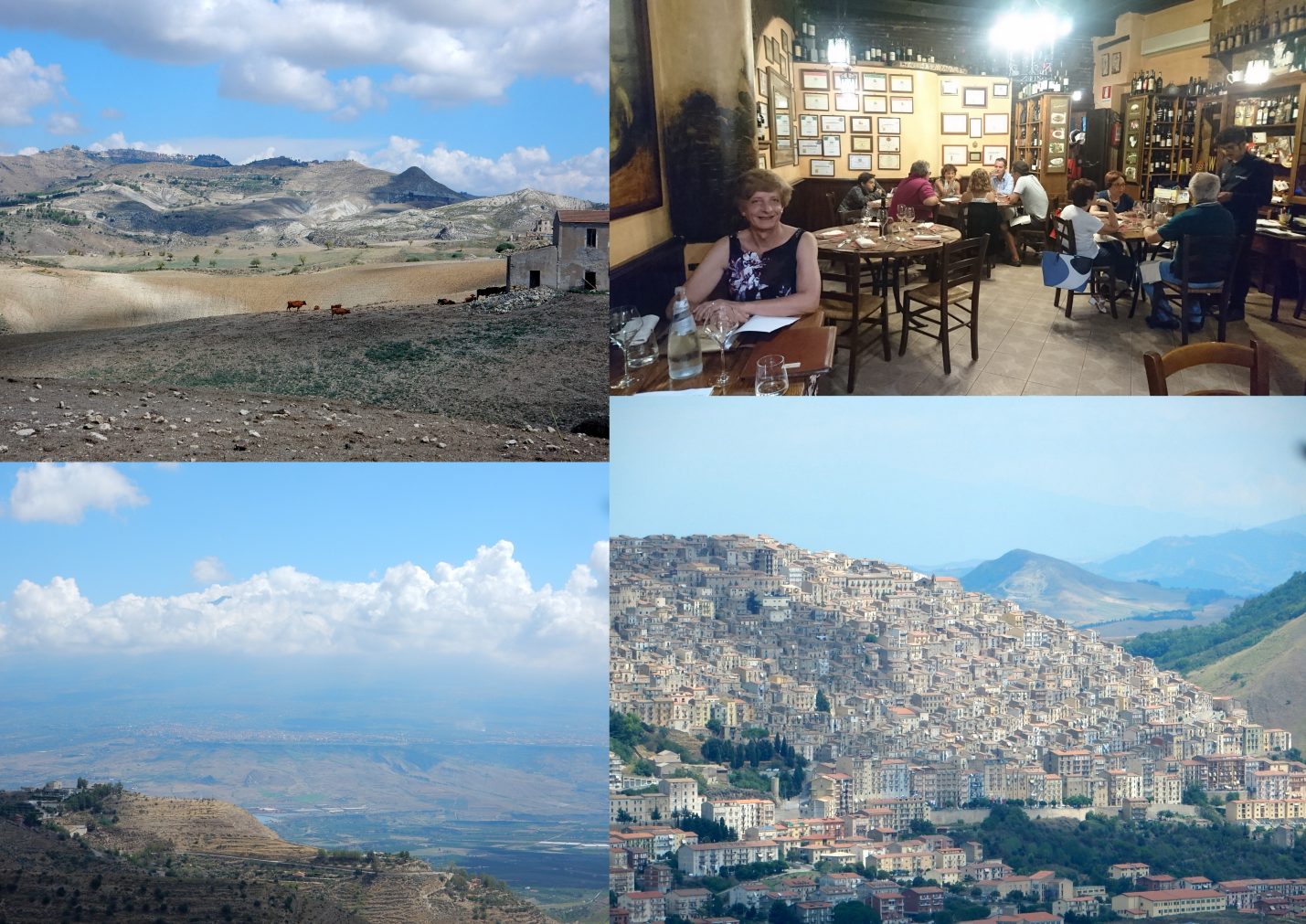
Castelbuono
17th – 20th August
Annabel and Justin had selected the mountain town of Castelbuono as the location for their Wedding Celebrations. We met up with the other friends and family at a converted monastery, the Relais Santa Anastasia. The keynote events were held on Saturday and Sunday nights leaving us free to enjoy the hotel or visit Castelbuono during the day.
Visit to Castelbuono
We gave Ros and Harold a lift into town on Saturday morning. Parking near the castle at the top end of town was relatively easy early in the day. The castle is more of a fortified house with a history of being a residence rather than a military stronghold. Inside there are a series of museums. One room had an interesting sequence of posters illustrating the development of the town. From the windows of the castle there are good views over the town framed by the mountains beyond. We wandered round the rest of the town but there was little of particular interest to see. The mountain weather was a bit unpredictable, but we found somewhere sheltered to have lunch.
Celebrations
We stayed in the hotel on Sunday dodging the heavy mountain showers. As the afternoon passed thunderstorms started forming in the mountains, and there were flashes of lightning through the night.
Palermo
After saying goodbye to other guests who were up early for breakfast we paid our bill with the hotel and headed off down the road towards Cefalu. The tolled expressway along the coast was very fast, bypassing Cefalu in a series of tunnels the longest of which was nearly 3km. As we neared Palermo the freeway turned into a multi-lane urban road with few indications what each lane was for. As a result we missed the intended turn-off into the city and had to navigate back from the next exit.
| A change of plan We reserved our accommodation for the holiday well in advance, as August is the peak holiday season in Sicily. Our final stop in Sicily was to have been the favourably reviewed B&B Dimora dell’Etna. But whilst we were touring we received an email from the owner saying he had been admitted to hospital and could we cancel our reservation. There followed a search for any accommodation in the same area that still had vacancies and had a half-decent reviews. Using lastminute.com we narrowed our choice down to an agritourismo slightly further north, so we booked that for two nights. |
Palermo was edgy. There was lots of rubbish on the streets, police cars everywhere, and for the first time other cars hooted at us. Luckily we didn’t plan to go very far into the city. We parked in Piazza Cappuccini outside the entrance to the Catacombe dei Cappuccini. Although the Piazza was free parking we were approached by a very rough looking man who ‘helped us’ into a parking spot then indicated that payment was required. We put this down to our first and only contact with the mafia who are entrenched in Palermo.
Before visiting the catacombs we took a look round the above ground necropolis. Many of the tombs were clearly maintained by descendants and the vast area of tombs had a happy sunny feel. In contrast the underground catacomb was vaguely spooky. The tall passages were dug starting in 1600 to provide space to store bodies. The mummified bodies were dressed in their clothes and then stacked on shelves along the wall. There are different ‘streets’ for different categories of people such as “virgins, professionals, clergy”. It was certainly challenging to visit a place of last repose with so many actual dead bodies, the sort of place that inevitably has you thinking about your own mortality.
Having paid the right people to look after our car we decided to leave it parked and look round a bit. A few blocks away was the Castello della Cuba, a rectangular, 12th-century Arab-style pavilion, used as a summer palace. The shell of the palace is only moderately interesting but we paid the admission because it also included access to the Phoenician Necropolis down the road. We asked (in broken Italian) if there was a guide available to let us into the Necroplis and got the answer “yes – but look round the Castello first”. So that is what we did. Then, when we were ready to go down the road it appeared that the guides had slunk off to lunch. Palermo appears to really struggle with the concept of tourism!
Undeterred we wandered down the Corso Calatafimi passing some grand buildings such as the Real Albergo dei Poveri (a baroque 18th-century property once a poor house, now used for exhibitions). We contented ourselves with a glimpse of the Palazzo dei Normanni from the Piazza Indipendenza – the queue to get inside was more of a crowd.
All the lunch options we had pre-selected were now either full or closed. So we gambled on the Bar Santoro in front of the Palazzo. This faded pavilion had the strange arrangement that food had to be ordered inside at the counter, but there was table service for drinks. It wasn’t a particularly pleasant place to eat, there were beggars and other unsavoury types roaming about, and the restaurant had just one dysfunctional toilet with a queue.
So without any mixed feelings we said goodbye Palermo and climbed into the hills to Monreale.
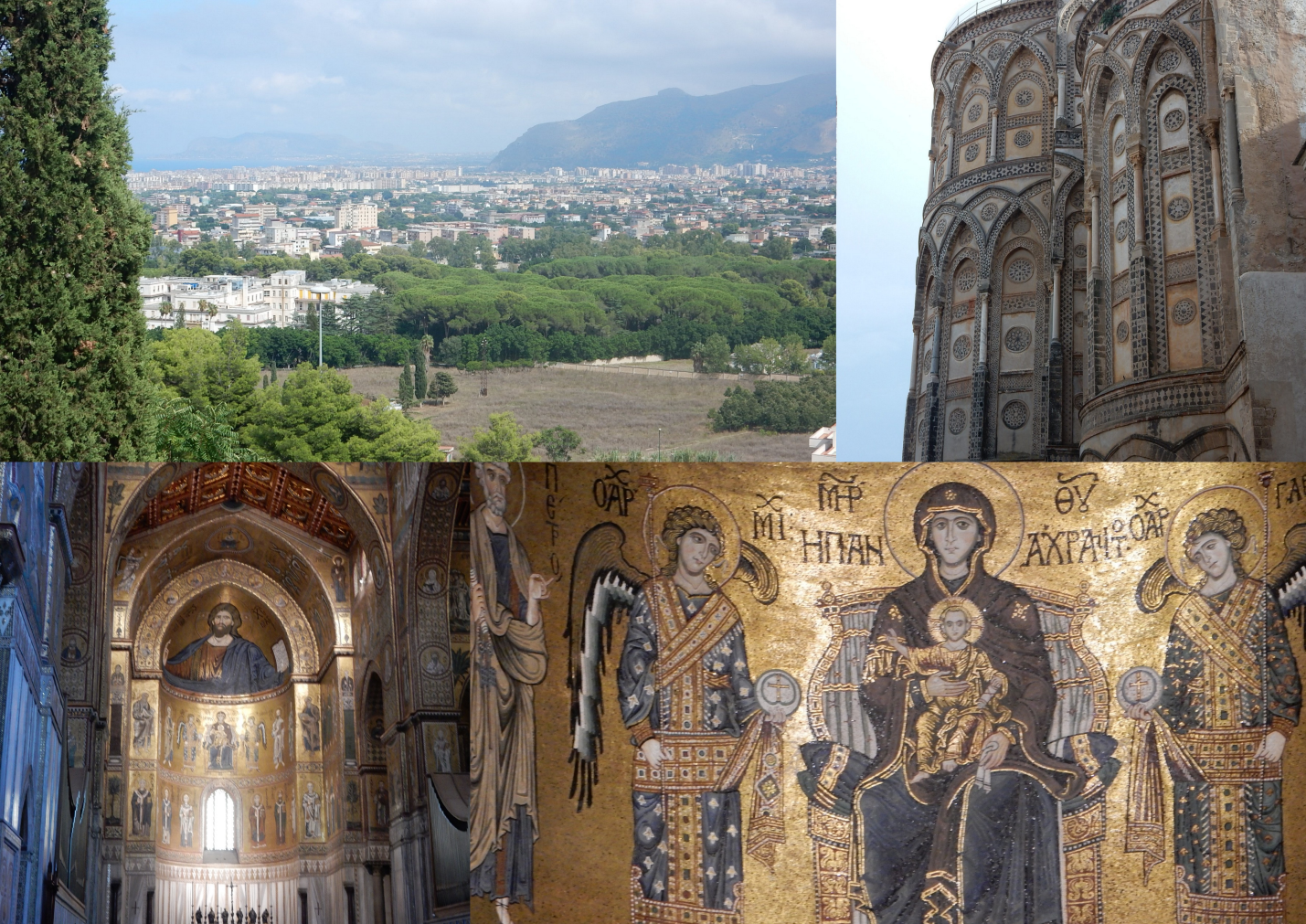
Monreale
20th – 21st August
Our accommodation for one night was the unusually named B&B Hootel Duomo Monreale. It was in the most convenient location for sightseeing (the main piazza) and the most inconvenient location to drive to. Because the piazza is a pedestrian zone in the daytime, we parked in the cramped Duomo Parking – a sort of multi-story car park built on the side of a steep hill. We had packed our overnight essentials in carry bags and left the two suitcases in the car. As we were walking to the piazza we were contacted by the owner of the B&B and he met up with us to let us in. We were expecting a bedroom, but instead had a mini-suite with a separate living area decorated with amphora.
It didn’t take us long after arrival to unpack our small bags, so we were soon wandering round Monreale. The main reason for visiting was to see the cathedral. It is one of the greatest extant examples of Norman architecture, constructed in 1174 by William II of Sicily. But it was getting late and close to closing time so we decided to leave viewing the inside of the Cathedral to the next day. Instead we looked round the outside, admiring the Arab influences on the highly decorated Eastern apse. It was a balmy summer evening so we dressed for dinner and then had an Aperol Spriz looking out onto Piazza Vittorio Emanuel. The owner of the B&B had recommended a restaurant – which turned out to be the only non-tourist focussed place that was open. We sat indoors at Ristorante Re Ruggero which was quite empty as everyone else elected to sit outside. Then suddenly the heavens opened and there was a big rush as the diners all relocated inside! Of course we didn’t bring our umbrella so we had to spin the meal out till the rain eased – any excuse to have dessert!
Alcamo
The B&B Hootel Duomo wasn’t really a bed & breakfast – because it didn’t serve breakfast! Instead we wandered out into the piazza and grabbed a light meal in one of the cafes. Being a major tourist attraction there were plenty of yellow tourist post boxes around and we were able to purchase the correct stamps for our postcards and post them. We didn’t have much confidence that the cards would actually be delivered (but they were after about 5 weeks). Without checking-out of the B&B we joined the queue outside the Cathedral and were one of the first people to be admitted. We were just expecting to see a few good mosaics and were blown away by the scale of the interior decoration. Every available surface was covered in pictures, all with an attention to detail, and all radiating a gold hue. The craftsmanship was inspiring, but as the visitors piled in, the church started to feel less like a place of worship and more like a railway station. We didn’t pay to see any of the extra add-ons – just seeing the main church more than justified traveling to Monreale.
| Coffee It is difficult to stay long in Sicily without being sucked into the coffee culture. It may sometimes be hard to find somewhere for a light lunch but there is never any difficulty finding a café. If in doubt you would just head for the Piazza Duomo. We did have two challenges getting our fix of caffeine. Firstly, the Sicilians could not make a decent cappuccino. Milk coffee is not their forte as they only consume it for breakfast. Most of the cappuccinos we ordered were topped with a light fair-floss milk foam – not the real milky taste we have become accustomed to in Sydney. Secondly we were unable to overcome the challenge of being served a small glass of water with our black coffees. We would see people drinking at the bar being offered a paper cup, and see others sitting outside being served a glass of water. But however hard we tried and how many times we asked we were never given water. Perhaps they thought their tap water wasn’t good enough for a foreign tourist? |
After collecting our bags it was time for a coffee (it is always time for a coffee in Sicily) and then, with some difficulty, we extracted the car from the Duomo Parking.
We made an on-the-spot decision to visit Alcamo on our way to Erice. The town looked interesting in the Eye Witness Guide and it was just about in the right place to find lunch at the right time. It actually turned out to be a very pleasant town largely bypassed by tourists. Our attitudes to Alcamo were possibly coloured because it was the only town where we found it was easy to park! The streets in the old town were mostly pedestrian zones and had a feel of affluence (in stark contrast to Palermo).
The Basilica di Santa Maria Assunta dated from 1402 but the attractive frescos on the nave vault were a later addition in the 18th century. One of the chapels on the right side of the nave contained a marble triptych representing Madonna between Saints Philip and James dating from 1519.
We wandered as far as the castle but didn’t go in as it was close to lunch time. After viewing some suggestions from Google (which were either closed or non-existent) we settled for lunch in a busy café on Piazza Ciullo. The café shared a common Sicilian problem in that the price of items on display was not shown. The price was always reasonable but the uncertainty about the bill was annoying. Pearls started to fall out of Adrian’s pants as we were eating lunch. In the hurry to get dressed that morning a (fake) pearl wristband had got caught up and disintegrated there!
After lunch our next stop was going to be Sueesta to see the temple (unfinished) and amphitheatre. As we approached on the freeway the site was clearly visible on the top of a ridge. We took the sign-posted exit and headed up to the site only to be told to turn round and go down the hill again. We had shot past the official car park for visitors which was a long way back by the freeway. For extra cost you could buy a ticket for a shuttle bus to avoid the uphill walk. At this time heavy clouds were gathering, and flashes of lightning could be seen in the mountains. We reasoned that it wouldn’t be long before it started raining at Segesta, and by the time we got to look round we might have to beat a hasty retreat. So we carried on driving west to the coast.
Google’s route to the hill top town of Erice where we were staying had to be abandoned when the road had a barrier across it saying it was closed. This meant we had to take a circuitous deviation through the outskirts of Trapani and approach from another side. The well-engineered road wound up 750m with a series of hairpin bends, but at the top there was no space to park (legally) by the town gate. Instead we gate crashed a “residents only” spot, left our luggage in the car, and without wasting any time headed up the steep cobbled main street to the Hotel Elimo.
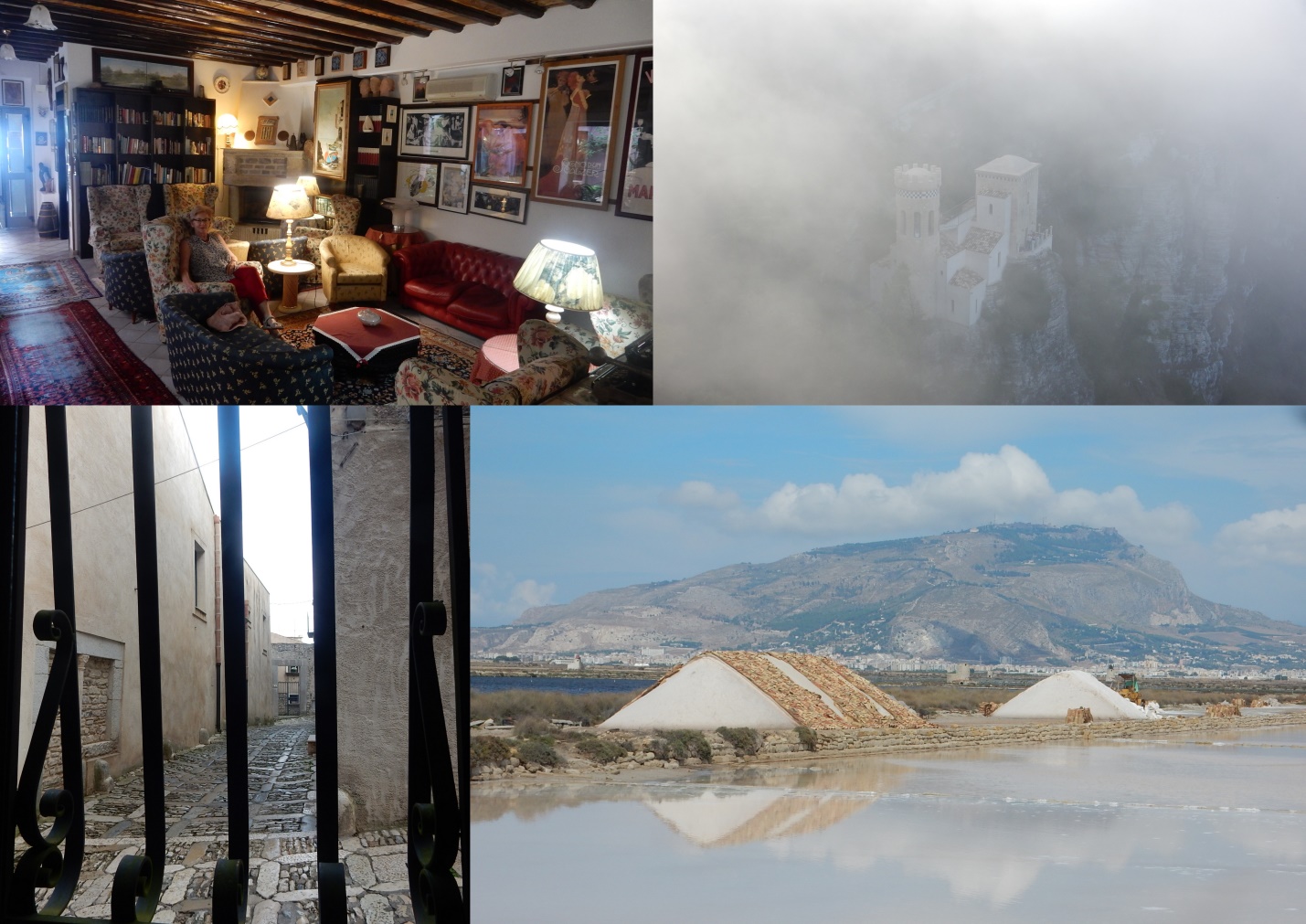
Erice
21st – 24th August
Erice is a delightful hill town perched on a mountain high above the coastal city of Trapani. It is completely over-run by visitors by day, and quiet at night. The Hotel Elimo, highly recommended by Trip Advisor, was within the old town walls and therefore virtually inaccessible by car. The ever helpful Antonio who ran the hotel offered us a number of choices for how to manage our car during the 3 night stay. Because we had already collected a parking dent in the car we opted to let him valet park the car in the hotel’s small garage. The hotel was a charming rambling set of rooms round a central courtyard. At the back there was a dining room with a view down to the coast (when we weren’t up in the clouds). Our room was at the front, at street level, so there was a continuous procession of visitors past our window. Their snatches of conversations were quite noisy, but late in the evening when the town went to sleep, the chattering stopped and we enjoyed undisturbed nights. Annabel and Justin joined us in Erice for the first two nights and for a day sightseeing the west coast.
Just after we stepped inside the Hotel Elimo the thunderstorms caught up with us and it started to rain heavily. We were glad that Antonio offered to park our car in the garage and bring us our suitcases. The meetup with Justin and Annabel went more smoothly than our earlier rendezvous in Catania; they checked in soon after us. Soon we were dressed for dinner and enjoying a complimentary Spritz in the lounge. Antonio recommended a restaurant to us and made a reservation – he was a perfect host! Luckily the rain blew over before we headed out on foot to find our dinner.
Masala & Trapani
We formed our plans for our day together sightseeing over breakfast. Annabel and Justin wanted to visit a winery in Marsala so Antonio was called in to help. After a few phone calls he found a place that had a tasting at a suitable time and made a reservation for them. He also recommended that we took the Valderice road down from the mountain which indeed turned out to have fewer bends that the route up from Trapani.
We had to head directly to Marsala to get there in time for the tasting; well as direct as any Google route ever was in Sicily. We deposited the tasters at the Donnafugata wine estate and set off on a hunt for somewhere to park the car nearer the historical centre of town. Being early we struck lucky when Megan spotted a free parking place along the sea front.
It was a short walk to enter the old town through the Porta Garibaldi. Inside was a “zona traffic limitato” which meant the streets were largely free of cars, and allowed the restaurants and cafes to spill out into the narrow streets. The mother church on the small central piazza was dedicated to Thomas Becket of Canterbury. This unusual choice of patron saint was a result of the Normal invasion of Sicily.
| Navigating with Google (2) Google Maps made a brave attempt at creating cross-country routes in Sicily. Away from the towns it was confused less by one-way streets and mule tracks, but instead by the vast difference between newly engineered roads (presumably built with EU finance) and the old roads that wound through villages and round fields. As a result Google would plot routes that seemed to defy logic, patching together spells driving down a fast new road in the wrong direction, and then winding on an old road to get back closer to the desired course. In general we trusted and adopted the Google route, except for a couple of occasions when the phone suggested a circular deviation that clearly returned back to where we were! Throughout the trip we relied heavily on the phone for navigation, but the Australian pronunciation of places and road names was unhelpful and amusing at times. Google directed us onto to provincial road numbers, but these numbers were rarely displayed on any road signs. |
After a coffee stop that included a super-size Cannolo we reached the Bastione Nord and started to retrace our route back to the car. Fortuitously we noticed signs describing various city walks and were able to follow one which took a different route passing some poorly maintained and labelled archaeological ruins.
By the time we had returned to the car and driven back out of town, Annabel and Justin had relocated to Cantine Florio where we picked them up. For lunch the choice was between a smart restaurant by the tasting rooms clearly built for the coach trade, or to head back into the old town where there was a wide choice of eateries. Despite the potential difficulties parking we decided to go back to the Centro Historico. Driving down the streets where we had earlier walked to the Porta Garibaldi we struck lucky as a car pulled out of a spot in front of us. Adrian wanted to sample to local specialty of Fish Couscous but it turned out that nearly every restaurant offered it. So we chose Natura a tavolaas as it also had a wide range of Masala wines that Annabel could sample.
Heading back we followed the coast so we could see the extensive salt flats which are still used to harvest sea salt. The windmills, used in the past to pump brine and to grind the salt, are an attractive part of the landscape. We stopped at the Imbarcardero where small boats leave to cruise on the lagoon, but there wasn’t time for a boat trip to Mozia island.
In Nubia, just south of Trapani, Google navigated us to the Museo del Sale, where for a small entrance fee we were given a guided talk about sea salt harvesting; it was most informative. The museum is inside an old windmill and there were great views from the roof over the flats to Trapani.
Our final stop before returning to Erice was suggested to us by Antonio, a well-regarded place to get granita in Trapani. Although we had vowed never to try parking in Trapani, the thought of a nice cold drink was compelling. After cruising round for a while we came across a piazza that had some vacant pay-and-display spots. The parking meter co-operated by accepting our change and printing a ticket, and we had an easy short stroll to the small restaurant.
Back on top of our mountain the cloud came down as usual. We walked to the castle (Castello di Venere) but there were only occasional tantalising views as gaps in the cloud blew past. It wasn’t very pleasant out, so we returned to the hotel, and made a booking for dinner.
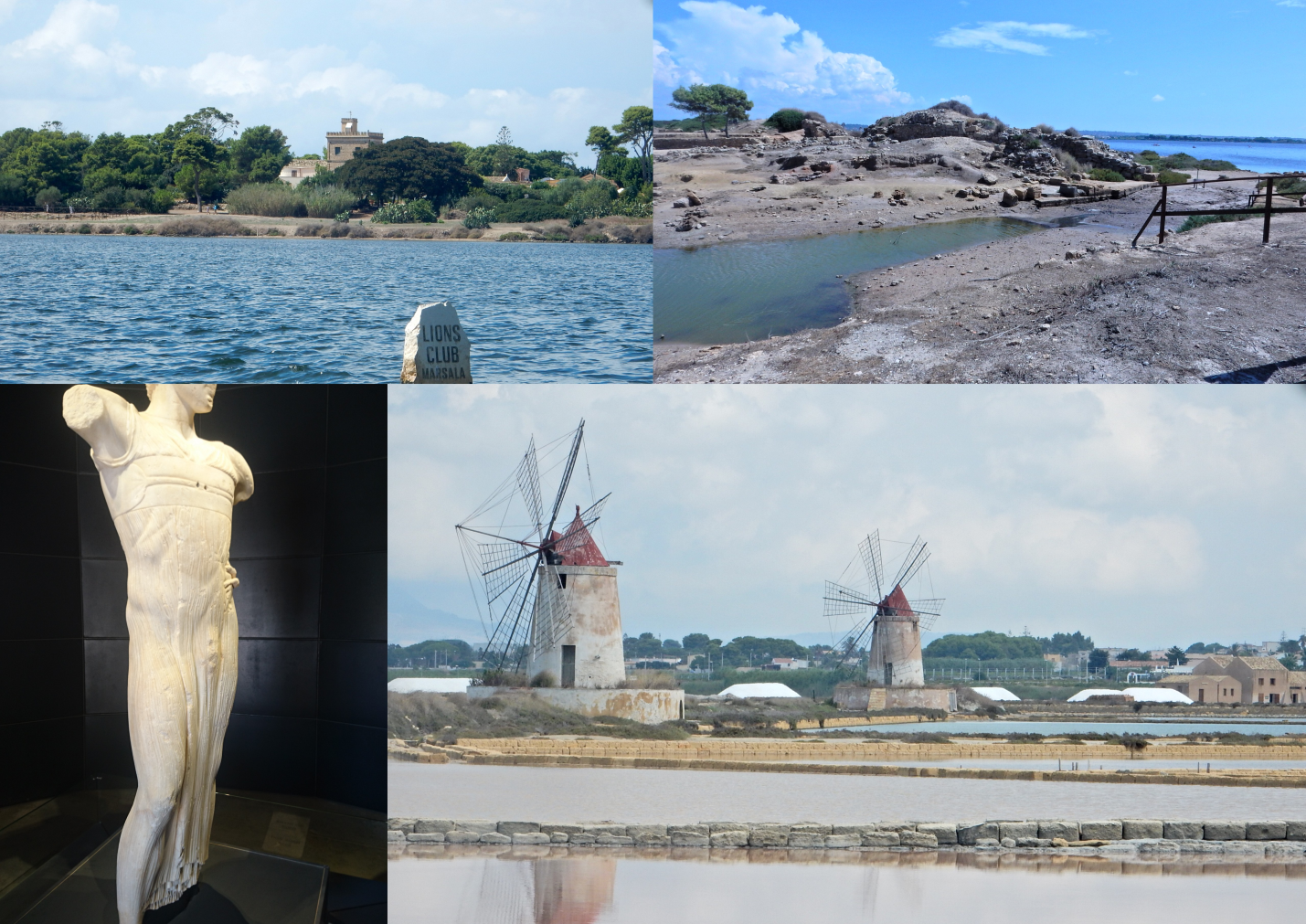
Mozia
We said goodbye to Annabel and Justin, who were heading east to Catania, and then we retrieved our car and headed back to the Imbarcardero. There was plenty of space in the free car park, and buying tickets for the ferry was easy (though there was an attempt to upsell us a complete tour of the lagoon). With our tickets in hand we headed to the canal that provides a harbour for boats and boarded the only boat there. Someone cursorily looked at our tickets and we settled in for the ride. As the boat filled up the skipper returned and said a lot to us in Italian. Luckily a young man translated for us, telling us that we weren’t in the Mozia ferry we were in the lagoon sightseeing boat. Apparently the Mozia ferry couldn’t come down the canal to the wharf. So we jumped out and walked up the canal tow path to the lagoon where after about 15 minutes a much bigger ferry came to pick us up. When we reached the island after 10 minutes we had to pay a separate admission fee which also included the museum.
Mozia was an important colony of Carthage founded at the end of the 8th century B.C. It was sacked by the Greeks of Syracuse in the 4th century B.C. after which the island was abandoned to sand dunes, and the lagoon silted up. It is quite rare to see such extensive Carthaginian ruins, and so much evidence of Phoenician culture.
We quickly looked round the museum before it closed for lunch. The star exhibit was a statue known as “The Youth of Mozia” – a remarkable athletic sculpture dating from the 5th century B.C. Having done the museum it was time for us to do lunch – sandwiches from the small café on the island eaten outside under some shady trees. It was a hot day and we didn’t have the time or inclination to make the full tour of the island, so we opted instead to take the shorter route round the SW corner. This took us past extensive Phoenician residential complexes, the city wall with its gates and guardhouses, and a group of temples round a freshwater pond. We were expecting that ruins of this antiquity would be little more than a few stone foundations and were pleasantly surprised to find that substantial remains have been excavated; and there is clearly more hidden under the many mounds.
The ferry back to the mainland was running frequently, and so we didn’t have to wait long before we were able to set off home. On the ferry we could see that Erice was enjoying sunshine, so it was a disappointment that when we started to climb up through Vallerice the cloud came over. We spent our third night in the cloud – apparently this was an unexpected weather condition for Erice in August.
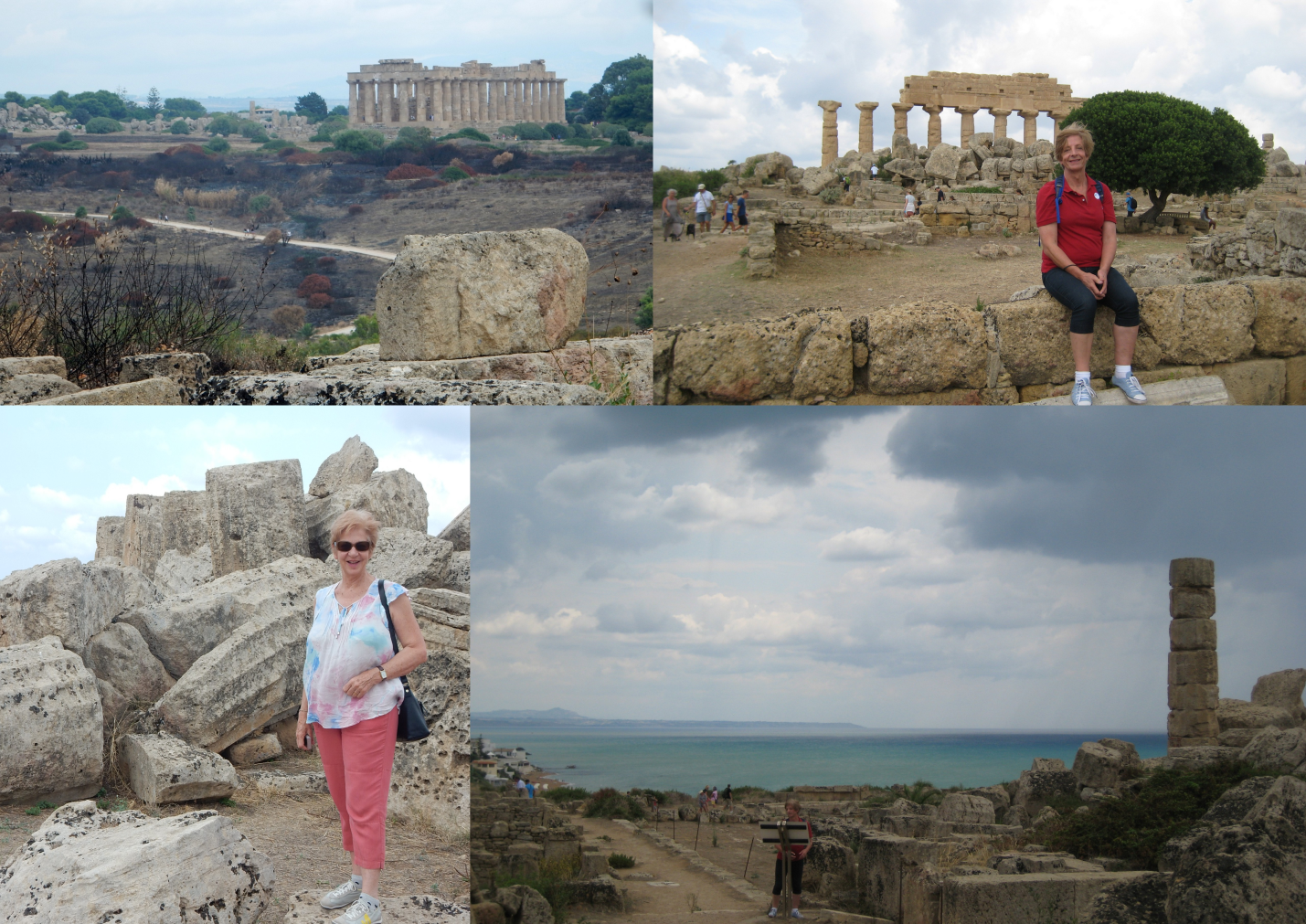
Selinute
Antonio had given us some suggestions where to go walking in the morning to see the best of Erice. But when we sat down for breakfast is was obvious that Erice wase still in the clouds. So we resigned ourselves to the fate of never actually exploring the town. With the suitcases packed into the car we farewelled Antonio and headed south towards Selinute.
The route Google chose for us started with a lot of turns onto and off local roads, but eventually settled down into a fast run on the E90 which runs from Palermo down to Mazara del Vallo in the SW of Sicily. When we turned off the E90 in Castelvetrano we joined a slow moving traffic jam. It was caused by the exiting traffic trying to turn left onto a busy road (no traffic lights, no roundabout; welcome to Sicily!). To make faster progress we took the right lane, turned right and did a circular detour through a largely abandoned industrial area. The number of empty commercial properties in industrial zones bears testament to the dire straits the Sicilian economy is in.
Thunder storms were gathering as we approached Selinute but as they didn’t threaten to rain on us as we paid admission to the large archeological site. Selinunte was one of the most important of the Greek colonies in Sicily. At its peak before 409 BC the city may have been home to 30,000 people. The current archaeological site covers about 40 hectares, so as we were short on time we paid extra for 2 stop “train” tickets. This allowed us to visit the Acropolis as well as the temples on the East Hill.
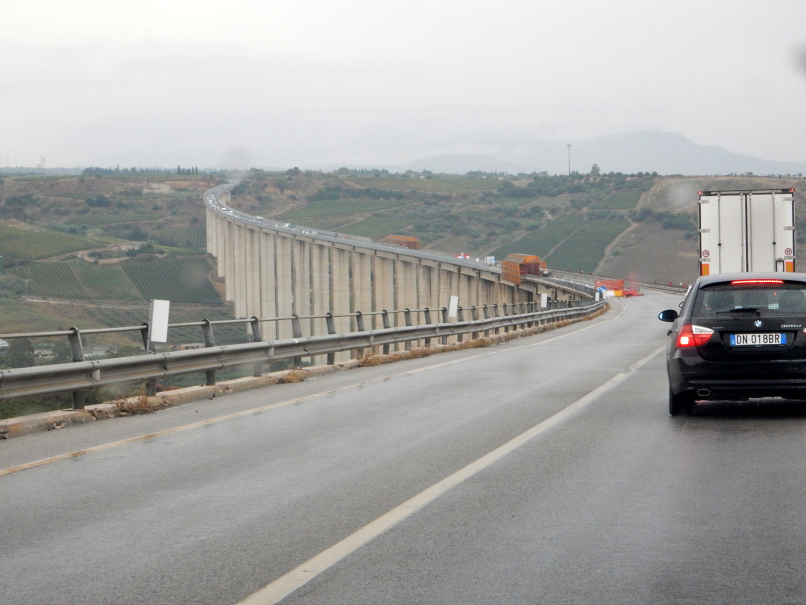
| Would you trust this bridge? The engineering for new roads in Sicily was impressive. To iron out the deep valleys and narrow ridges there were lots of high viaducts and short tunnels. It was however very noticeable that many of the high bridges were under some form of repair. It was comforting to think this was just normal maintenance to keep the structures in prime condition. But then whilst we were on holiday a bridge collapsed in Genoa killing 43 people. This somewhat sapped one’s confidence! |
The first stop on our train (actually a set of oversized golf buggies) was the three temples on the East Hill. Temple E was controversially reconstructed in the 1950’s but the other two temples are just a jumbled mass of fallen stonework. We looked in the Museum (as it was the stop to get back on the train) but there was little of interest on display.
The train took us down into the valley and up the other side by the impressive stone walls of the acropolis. There was one clear ancient street running through the area, and a partial reconstruction of Temple C. But the rest was just jumbled stonework. We had great fun (and got quite hot) exploring the maze of fallen columns, flagstones, and blocks.
Exhausted we caught the train back to the entrance gate and drove round the adjacent seaside town of Marinella di Selinute looking for lunch. Eventually we settled on Bar Cosi Duchi just outside the ruins that had a good lunch special – brushette. There was a downpour whilst we were eating and we got wet rushing back to the car afterwards.
From Selinute it was a long hard drive back to the east coast at Catania. Our route took us within sight of the Valley of the Temples at Agrigento –conveniently the temples are not in a valley otherwise we wouldn’t have been able to see them. We had no plans or time to look at this over-visited attraction and pressed on inland heading for the main freeway north of Enna. Initially the road was new and fast, but when we got closer to Caltanissetta we were diverted onto minor roads to avoid some major tunnel building. If that wasn’t slow enough, a short time later the road ahead was closed (probably due to an accident) and we were shunted off onto a back road that went to Ennna. As a result we got stuck in heavy “rush-hour” traffic skirting round the south side of the hill town and lost a lot of time before we got onto the dual-carriageway to Catania. We arrived in Puntalazzo much later than we had planned, but luckily we had been able to phone the accommodation to reassure them that we were coming, and also to request they cooked us dinner.
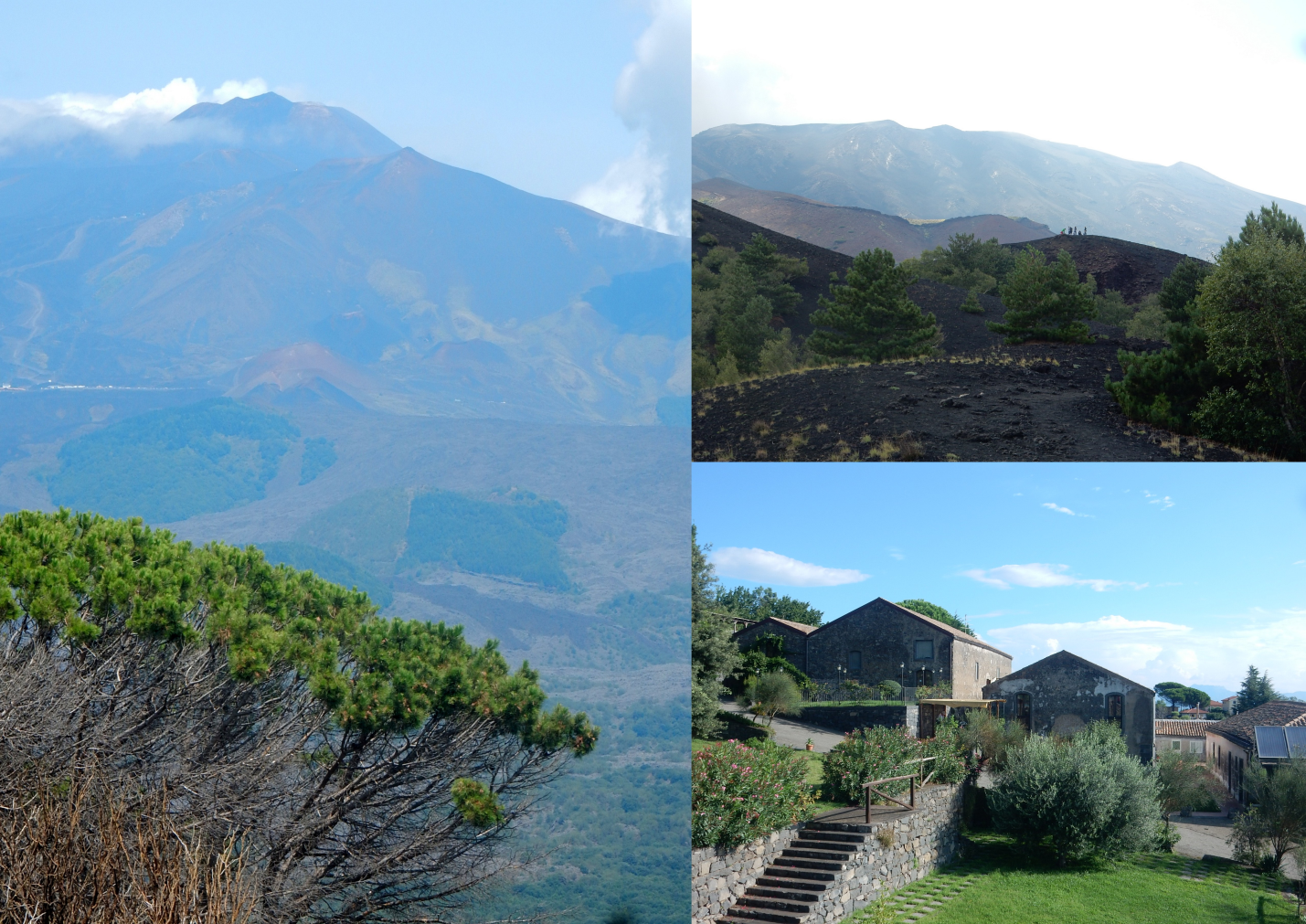
Puntalazzo
24th – 26th August
La Pietra Antica O’ Munti was not our first choice of accommodation on the slopes of Etna. But it did have vacancies over a peak holiday weekend. The Antica in the name refers to the buildings which were a converted wine press. The breakfast/dining area still had some of the original press and vats for the juice. Our room on the ground floor of an outhouse was large but sparsely furnished. It was not particularly welcoming; a bit like the owners who couldn’t manage a smile for us. Breakfast was an optional extra; both mornings we ate on our own.
We were exhausted after the long days drive, but after freshening up we headed up to the main building for our dinner. The rooms were dimly lit and deserted except for us. We ordered antipasta followed by soup (Megan) and pasta (Adrian) – it was adequate but not overly exciting. It wasn’t long before we both headed off to bed.
Etna
Megan woke during the night with food poisoning and was
subsequently off her food for a day or so. Adrian went to breakfast and came
back with a tray of tea and bread. It was clear that Megan wouldn’t be going
anywhere in a hurry so we abandoned the tentative plans we had to take the
Circumetnea train round Etna. Instead Megan went back to bed, and Adrian drove
off to the largest town nearby, Saint’Alfio, in search of lunch. In the
afternoon Adrian enjoyed a short walk on the lava fields, and Megan came along
in the car. The direct route from our accommodation up to Rifugio Citell was
quite hair-raising, with roads that were barely wide enough for two cars to
pass, and people driving downhill very fast. At one point we had to fold in our
wing mirror to get past a van coming the other way.
In contrast the road once we reached the national park was wide and well
graded.
Adrian parked the car at the trail head and then took a 4km circular walk that went round the Sartorius Mountains. The mountains weren’t particularly large; they were in fact pyroclastic vents dating from the 1865 eruption. There wasn’t a marked path but some waypoints downloaded onto Google maps gave some sense of direction when wandering on featureless lava fields. We took a longer way home, sticking to larger roads, and passing through Fornazzo and Saint’Alfio.
Unsurprisingly we didn’t ‘eat in’ at La Pietra that evening, instead we headed at opening time to a popular Pizza restaurant in Saint’Alfio. Megan didn’t actually want to eat anything so we ordered and whilst she pretended to nibble, Adrian consumed the lot!
The news that night was that Etna had started to erupt. We couldn’t see the glow from where we were staying, but it was visible to Annabel and Justin who were staying a bit further south of us. The minor eruption only lasted a couple of days and posed no threat to flights from the nearby Catania airport.
Catania
Megan accompanied Adrian to breakfast on our second day in Puntalazzo, even though she only wanted tea. When she headed back to the room, Adrian took some photos of the dining area and managed to drop the phone from a height onto a stone floor. It was surprising it still worked, but soon we found the Wi-Fi reception was very poor. Subsequently Adrian could be found wandering around like a water diviner trying to stand directly under hot spots!
After a very leisurely pack (it was all Megan was good for) we checked out (no smiles again) and headed south on narrow winding roads through numerous villages built on the lava flows from Etna. As everything was built from dark grey lava stone it was a pretty gloomy area. Our destination, for Megan to sit in the sun and Adrian to go walking, was Monti Rossi.
Monti Rossi is the double splatter cone resulting from the 1669 eruption. This was most violent historical eruption in the recent history of Etna, and the lava flow submerged western Catania. Nowadays the cones are a popular recreation area with panoramic views over Catania and back to Etna. We parked in the picnic area which was busy with families cooking barbeques. Adrian set off on a walk using a photograph of the sign at the park entrance. Unfortunately the map had a clearly marked INGRESSO which wasn’t actually the entrance we had entered! As a result what should have been a nicely contoured walk round the craters turned into a scramble up a badly eroded path in slippery volcanic ash. The views from the top were however worth the effort getting there. It was only a few days later when reviewing the photos on the phone that Adrian found the scribbled words “You Are Here” on the sign.
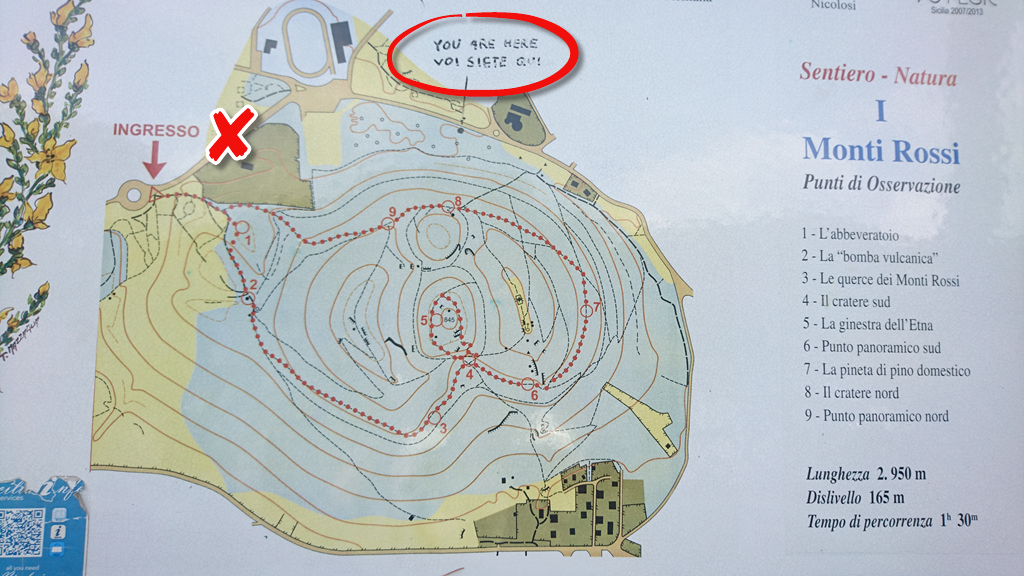
Heading Home
26th – 29th August
Our final night stay in Sicily was in the Catania Airport Hotel. A smart well run modern hotel located in the middle of a very run down industrial area. Its main attraction was its proximity to the airport. The next day we flew to Istanbul, and after a long lay-over flew overnight to Bangkok and Singapore. We paid for the convenience of a good night sleep in the Crowne Plaza T3 in Singapore Airport before hopping onto a daytime flight home to Sydney.
Our holiday in Sicily was rapidly drawing to a close and in preparation for the early flight to Istanbul the next morning we checked into the Catania Airport Hotel.
The check-in at the Airport Hotel was friendly, efficient and all smiles – such a contrast with the dour family running our previous accommodation. After moving the cases to our room (conveniently right next to the lift) Adrian drove the car to the airport rental drop-off. The process of dealing with the parking dents we had picked up was efficient; the repair cost was agreed on the spot. Our holiday insurance would cover the excess so we weren’t too concerned. Whilst it was easy to drive from the hotel to the airport, walking back was a different matter. First one had to wander through rental car yards, and then walk on the side of a busy road without footpaths. It was not an activity to be tried after dark so it was good we returned the car early.
Back at the hotel there was time to have a swim in their new pool before the thunder clouds gathered and it started to rain. The hotel had an unusual policy of requiring everyone to wear a bathing cap – so we bought one to share between us. Sicily doesn’t seem to have heard of slip resistant flooring, and walking back to the hotel in the rain the polished stone paving was a like an ice rink.
We had a low key meal in the hotel restaurant with Megan still pretending (quite convincingly now) to eat.
Singapore
We got an early shuttle from the hotel to the airport – at 6:30 it was just dawn and Etna rose clearly above the city without any cloud at the summit – just a plume of smoke from the crater. We weren’t in any particular hurry, so it was no concern to us that our flight from the small international (non-EU) gate at the airport boarded very late.
In a couple of hours we were back at Istanbul with a 7 1/2 hr lay-over to enjoy the magnificent business class lounge. This would be our last visit to the old overcrowded Ataturk Airport as in a couple of months it was planned to close and be replaced by a new airport. Our onward flight was delayed, so we went back to the lounge to wait. When we did board the meal service was very efficient (Megan was back to eating!) and we both got a reasonable sleep on the flight to Bangkok.
In Bangkok we followed a very familiar route through immigration, baggage claim, and back out through departures. We were now Economy class passengers heading to Singapore. We found somewhere quiet to sit whilst waiting for our flight to be called.
The Crowne Plaza Hotel right inside Singapore terminal 3 is an expensive option, but it is ultra-convenient, just a short walk from baggage claim. We were pleased to see that the pool hours had been relaxed since our last visit and so we were able to have a swim before heading to bed.
Our flight the next day to Sydney was uneventful and familiar. By 10pm we were home inspecting the garden and shivering in the cold of a Sydney winter.
In Conclusion
Adrian’s Thoughts:
Sicily wasn’t a destination we had ever planned to go to – so I approached it without any preconceived ideas about how good it would be. From the first day the unique experiences delighted me, and it stayed that way for the rest of the holiday.
Italian food in Sydney is very predictable, and I was not looking forward to 3 weeks eating it. The variety of food in Sicily was a pleasant surprise, as was the way that it changed over comparatively short distances as we travelled around.
We hired a car with some trepidation as much is written on line about how bad the drivers were. This turned out to not be true, just like anywhere in the world the locals have some surprising habits, but driving was in general an enjoyable experience. Parking on the other hand was always a challenge. Sicilians have raised parking to an art form.
Megan’s Thoughts
Our Italian holiday exceeded expectations.
Naples was relaxed, clean, and had some lovely streetscapes and places to wander. No feeling of danger or of the edginess that it used to have.
Sicily was full of delights and surprises. There were so many spectacular hill towns, wonderful churches, Baroque monuments, all kinds of architecture to admire. The views of the sea and coastline, all so lovely.
Traffic and crowds were to be expected in mid-summer in Europe, but they presented a challenge that we seemed to manage. Adrian’s driving skills were something to behold; driving quite like a Sicilian and I wasn’t even scared!